Manitoba
Raymond M. Shirritt-Beaumont
Raymond M. Shirritt-Beaumont, “Manitoba,” in Canadian Mormons: History of the Church of Jesus Christ of Latter-Day Saints in Canada, ed. Roy A. and Carma T. Prete (Provo, UT: Religious Studies Center; Salt Lake City: Deseret Book, 2017), 328-359.
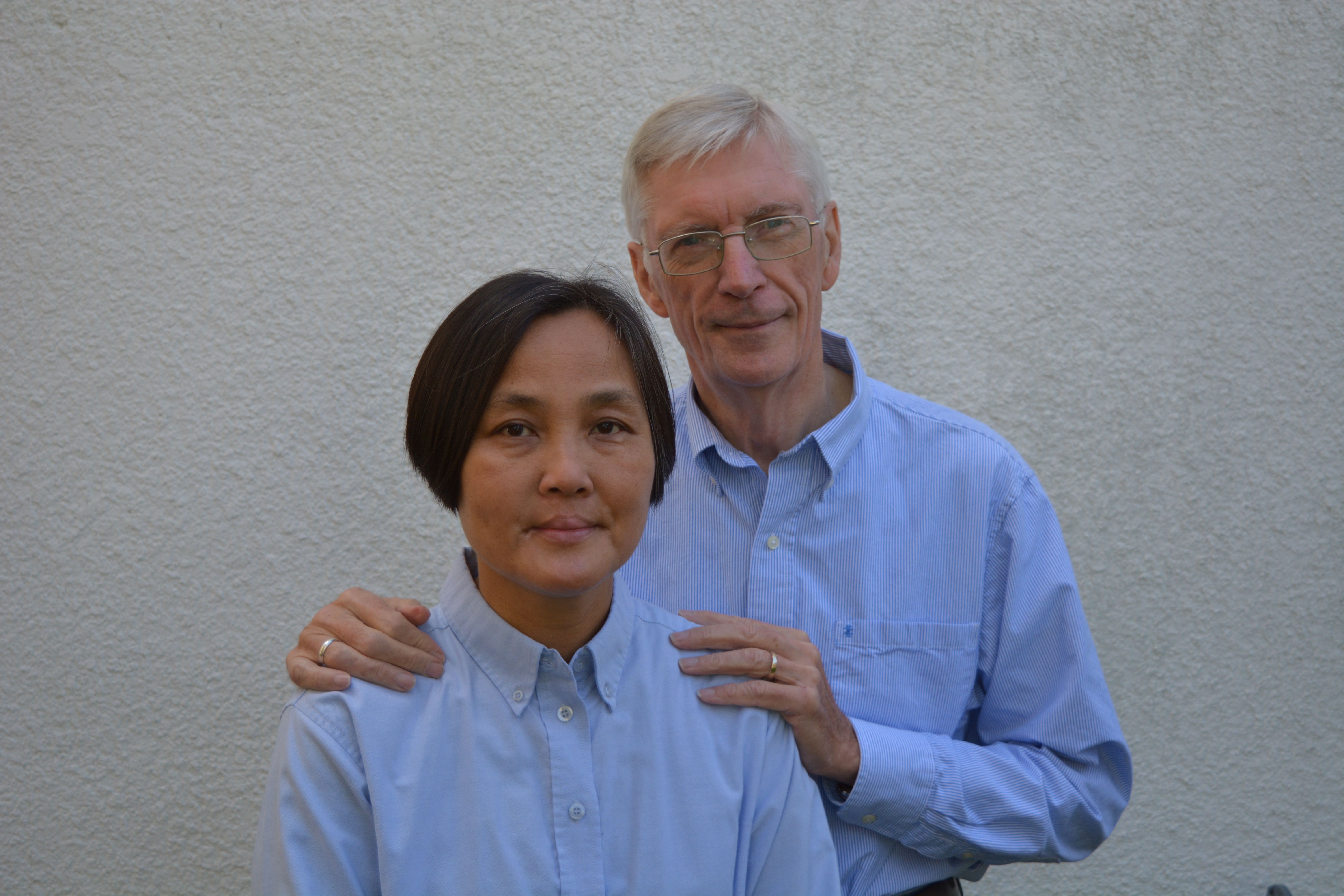
Raymond M. Shirritt-Beaumont (BA, 1963; Cert. of Ed., 1965; MA in history, 2001), educator, researcher, and historian, worked as a teacher and school administrator from 1963 to 1986 and as a researcher and writer in curriculum development and educational consultant from 1986 to 2010, all in Manitoba. He has conducted many educational workshops on the teaching of history, emphasizing Aboriginal history and culture, and has eighteen publications to his name. His awards include the Margaret McWilliams Medal (1992) for best university essay; the Paul H. T. Thorlakson History Award (1995) for a paper illuminating methodological and interpretive problems in Manitoba Aboriginal historical research; and the Margaret McWilliams Award (2002) for best thesis. Shirritt-Beaumont has served in various Church capacities, including teacher, auxiliary leader, elders quorum president, bishop’s counselor, and clerk. Now retired, he and his wife, Wan, live in Winnipeg, Manitoba. They are the parents of three children. (Kieran Shirritt-Beaumont)
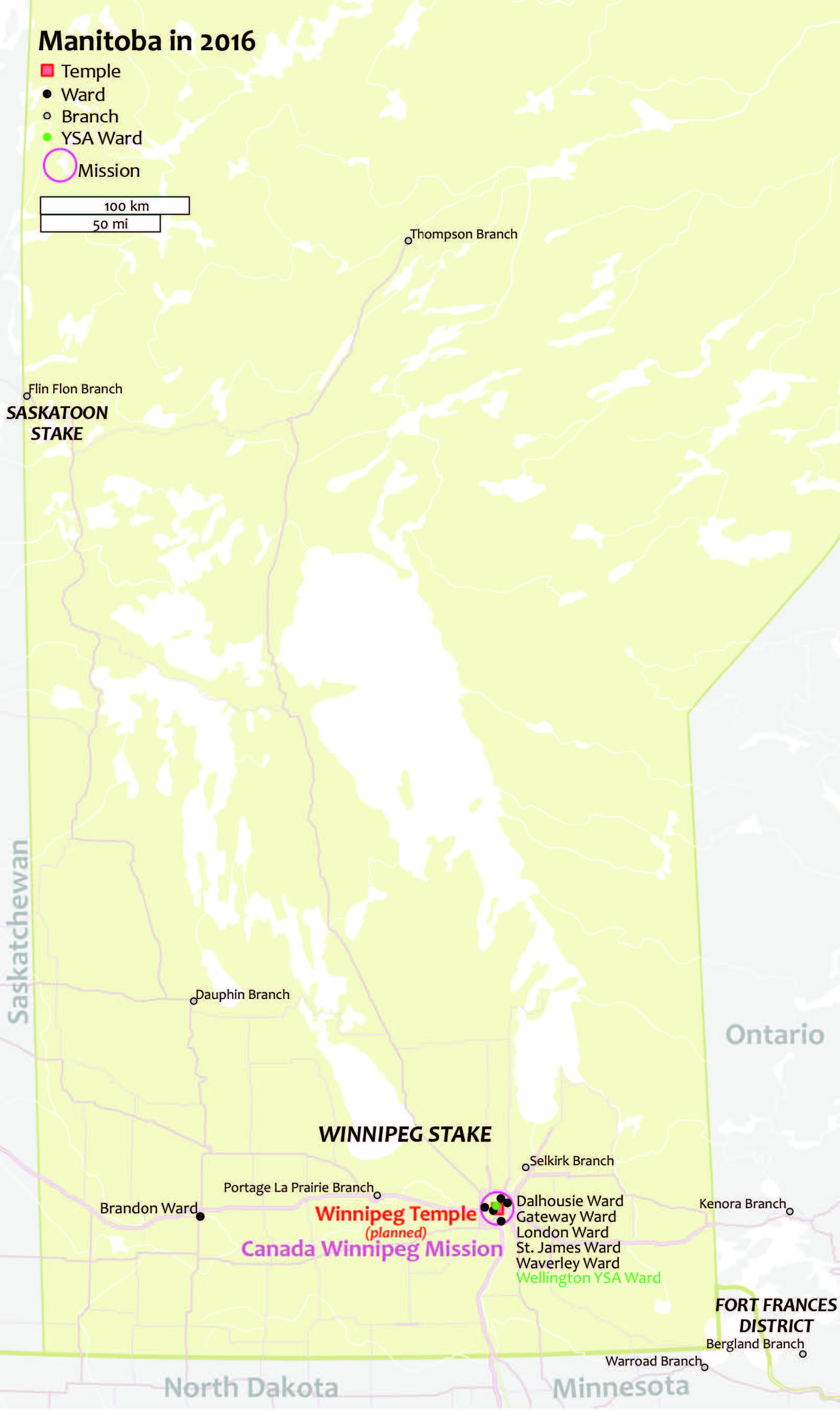 Manitoba became a province in 1870, though the original boundaries were extended in 1881 and again in 1912 to encompass its current borders. In 1879, it became the first province in western Canada to have Latter-day Saint missionaries. The Church in Manitoba grew through convert baptisms and move-ins from other places. Church members in Winnipeg constructed the first LDS meetinghouse outside Alberta in 1914. In the years that followed, branches were established throughout the province, and a stake was created in 1978. In 2011, President Thomas S. Monson announced that a temple would be built in Winnipeg.
Manitoba became a province in 1870, though the original boundaries were extended in 1881 and again in 1912 to encompass its current borders. In 1879, it became the first province in western Canada to have Latter-day Saint missionaries. The Church in Manitoba grew through convert baptisms and move-ins from other places. Church members in Winnipeg constructed the first LDS meetinghouse outside Alberta in 1914. In the years that followed, branches were established throughout the province, and a stake was created in 1978. In 2011, President Thomas S. Monson announced that a temple would be built in Winnipeg.
With the relocation of the Latter-day Saints to the Intermountain West after 1847, the focus of Church activity in both the United States and Canada shifted westward. Missionary work ceased for a time in eastern Canada with the last known missionary effort in 1877. Manitoba was the first area to be opened up for missionary work in western Canada. Although efforts in 1879, and later in 1884 and 1894, proved unsuccessful, missionary activity in 1897 produced converts, and by 1914, Winnipeg had the first LDS chapel outside Alberta.
The Church of Jesus Christ of Latter-day Saints in Manitoba has grown and matured, often slowly and gradually, to become a permanent presence in the province. The rate of growth has varied as Church members have moved to Utah and Alberta, and membership has even declined for short periods. Church membership in Manitoba, nonetheless, has grown through convert baptisms and through those who moved in from elsewhere. After a period of significant growth, the Winnipeg Manitoba Stake was formed in 1978. Total membership had reached 4,485 by 2015. The majority of Latter-day Saints reside in the Winnipeg area, but there are other wards and branches scattered from Brandon to Thompson. Latter-day Saint pioneers in Manitoba have created a vibrant legacy of faith for those who follow. The 2011 announcement that a temple would be built in Winnipeg was a crowning blessing.
Manitoba: A Unique History
For thousands of years, Aboriginal people occupied the forests and grasslands of a vast North American watershed, an area that covers all of what is now Manitoba and most of western Canada and the Northwest Territories. The natives of the region consisted of a number of linguistic groups, mostly tribal in social organization, who were often at war with each other along the boundaries of their separate territories, but at other times peacefully engaged in an intertribal trade network that stretched over the entire continent.[1]
This traditional arrangement of government and commerce was greatly altered in the seventeenth century with the arrival of French and English traders, who were interested in exchanging European goods for the high-quality beaver pelts and other furs available from the native hunters of the region. For a hundred fifty years, the Hudson’s Bay Company (HBC), which was directed from London, battled for control of the trade with various French, and later Scottish, fur-trade companies headquartered in Montreal. This rivalry ended only in 1821, when the HBC absorbed the North West Company, its last remaining opponent. Although its hegemony over the northwest had been successfully defended, the Hudson's Bay Company finally gave up control in 1869 with the transfer of its territories to the government of Canada.
By this time, most of the people in the territory were concentrated at the forks of the Red and Assiniboine Rivers, where the city of Winnipeg is located today. The vast majority were descendants of European traders and their native wives, and they were further divided into the English-speaking, Protestant “Country Born” and the French-speaking, Roman Catholic Métis. Alarm over the impending transfer to Canada, coupled with the high-handed measures of Canadian officials and newcomers from Ontario, led locals to establish a provisional government at Red River under the leadership of a local Métis leader named Louis Riel. Although the Canadian government suppressed this “rebellion” and forced Riel to flee to the United States for safety, his name for the new province and many of the rights he had drawn up for his people were later honoured by the government of Canada.
On 12 May 1870, the Province of Manitoba came into being. With boundaries confined to the extreme southeast section of the Hudson Bay watershed, and Winnipeg, its capital, little more than a village, this “postage stamp” province might have appeared inconsequential to those travelling through it at the time. Eventually, indeed, it would expand to its present boundaries and fully develop the agricultural potential of its prairie soils in the south and the forestry and mining possibilities of the Canadian Shield further north, but in 1870, this was yet in the future. Within a decade, however, that development was well under way. By the time the first LDS missionaries arrived in May of 1879, Winnipeg had become a city of nearly eight thousand people and was poised for even greater expansion as immigrants flocked to Manitoba’s unsettled prairies. Optimism was in the air.
Early Missionary Efforts
Economic growth was undoubtedly on the minds of Manitobans in 1879, but spiritual growth was the focus of the missionaries, who might have seen the very name Manitoba as a promising omen had they been aware of its meaning. Algonquian in origin, it can be translated as “the god who speaks—the speaking god” or “the Spirit is speaking! Listen!”[2] This was the central message that the missionaries wanted to proclaim.
The first LDS missionaries to Manitoba were Jacob B. Johnson and John Eyvindson, Icelandic converts who were sent from Utah in 1879 specifically to work with Icelandic immigrants in Manitoba. Arriving in Manitoba at the beginning of May, they conducted fifteen open meetings in New Iceland and Winnipeg before leaving for Europe on 21 August.[3] At times, they faced considerable opposition. According to one newspaper report in Winnipeg, “Two Mormon missionaries who were preaching near the immigration hall yesterday and trying to make converts were mobbed by the audience that had gathered to listen to them.”[4] This hostility may explain why they failed to make a single convert in Manitoba, although they later had success in Iceland. In 1884, Theodore Brandley and Samuel Wittwer, German-speaking Swiss converts, were sent to share the gospel with the Mennonite immigrants in Manitoba, but although they “visited all but 4 of the Mennonite villages in Manitoba 66 in number,” the people were not yet ready to receive their message. Similarly, when Jacob B. Johnson returned to Manitoba again in 1894 to preach to his fellow Icelanders, he was unsuccessful.[5]
Then, in January 1897, several new elders arrived. They came under the auspices of the Canadian Mission, which was headed by Charles O. Card, the founder of Cardston, a Mormon settlement established in 1887 in southern Alberta.[6] Prompted by correspondence from a Church member—John Sharman of Souris, Manitoba—Card had made inquiries with Church headquarters to see if a mission could be opened in Manitoba. This request was approved, and in December 1896, Niels Hanson, a member of the Alberta Stake high council, was called to supervise the missionaries who were to serve there.[7]
Once in Manitoba, Hanson, the mission leader, and three other missionaries, Willard S. Baxter, J. George Stuart, and Edward J. Leavitt, took lodgings at Brandon while three other missionaries, Alonzo G. Barber, Frank May, and Alva M. Merkley, moved on to Winnipeg.[8] Initially, they distributed tracts and visited with people along the streets of these two urban centres, occasionally meeting with investigators, like James Crittenden and Robert Ramsbottom of Brandon, in their own homes or at the missionaries’ boardinghouse. Later they began holding services for the public in rented halls.[9] However, missionary efforts were not confined to Winnipeg and Brandon alone. Eventually, missionaries were stationed for periods of time at the larger rural towns, including Portage la Prairie, Souris, Minnedosa, Carberry, Baldur, Hartney, and Wawanesa.
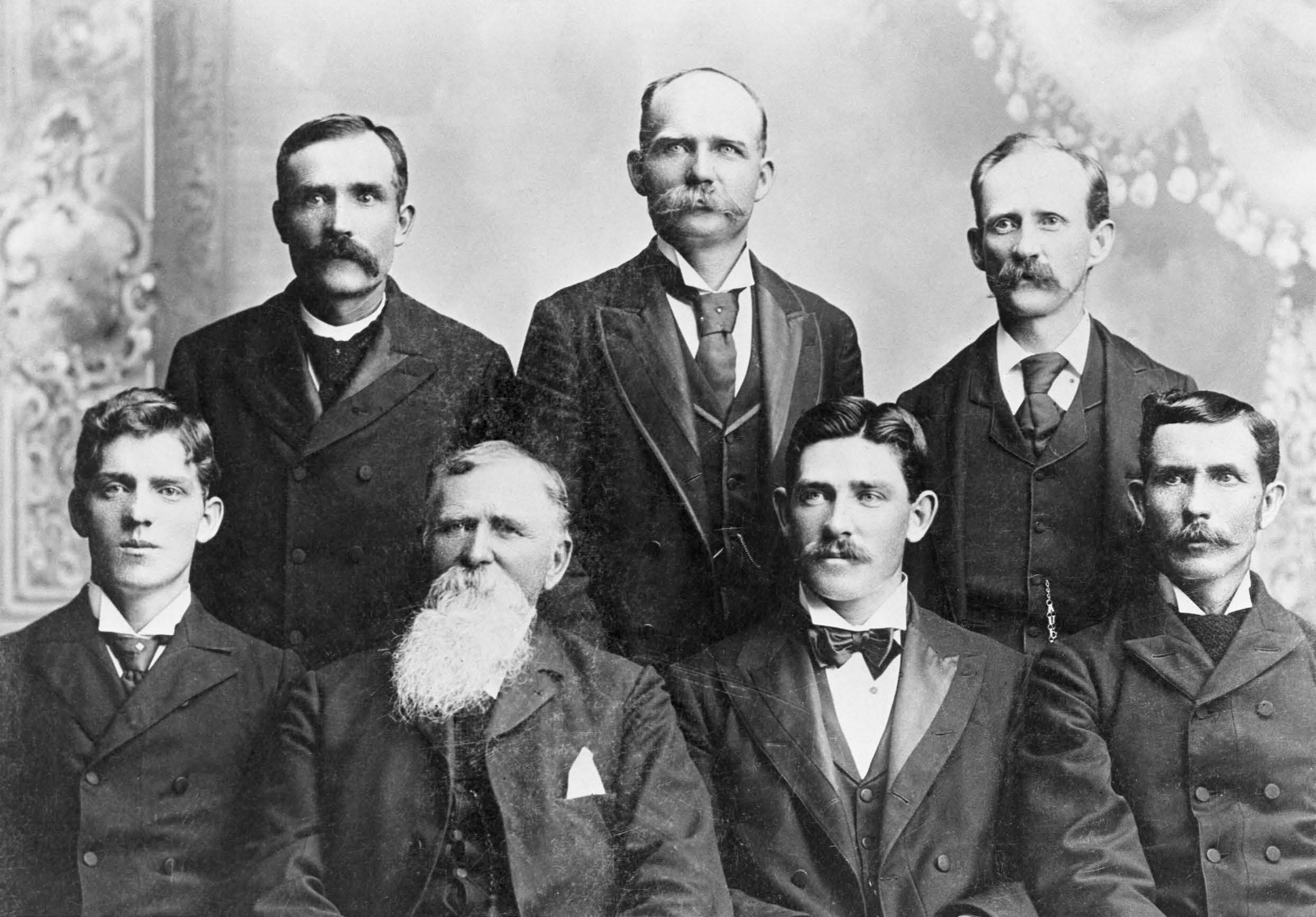 Seven missionaries—three from Utah and four from Cardston, Alberta—departed from Lethbridge in January 1897 to preach the gospel in Manitoba. This photograph was taken in Manitoba in November 1897. Front row, left to right: Edward Leavitt, Nels Hansen, Frank May, William Baxter; back row, left to right: James Stewart, Alva Merkley, and George Barber. (Glenbow Archives NA-114-16)
Seven missionaries—three from Utah and four from Cardston, Alberta—departed from Lethbridge in January 1897 to preach the gospel in Manitoba. This photograph was taken in Manitoba in November 1897. Front row, left to right: Edward Leavitt, Nels Hansen, Frank May, William Baxter; back row, left to right: James Stewart, Alva Merkley, and George Barber. (Glenbow Archives NA-114-16)
Elders Hanson and Leavitt made their first trip outside of Brandon in February 1897, when they visited Brother Sharman and his family on a farm near Souris. Such trips to the countryside became frequent, especially during the summer months, when the roads were generally better for travel by foot. Since they had limited money for board, the missionaries travelled without purse or scrip and had to rely on the kindness of strangers for their food and lodging. A trip in August 1897 illustrates this point. Setting out on 9 August, Edward Leavitt and Seavir A. Johnson travelled northeast, distributing tracts to the farmers and stopping at each district along the way to ask permission to hold a meeting in the local schoolhouse. They walked 160 kilometres on their journey and did not return to Brandon until 18 August. But during that entire time, there was not a day when they went without food or lodging for the night. Even the trustees who refused them the schools at Selden and Lorndale were hospitable.[10] Two neighbouring districts, Gordon and Glendale, not only fed and lodged the elders but also granted them permission to hold public meetings. The meeting at Gordon School did not transpire.[11] However, with a hundred people in attendance, the service at Glendale was one of the most successful up to that point in the mission.[12]
Unfortunately, Leavitt and Johnson could not capitalize on this promising start. They simply lacked the resources to do so. Like the other missionaries, they had arrived in the mission field with some funds, but they often had to appeal to their relatives and friends back home for additional money when unforeseen expenses occurred. The mission was likewise strapped for cash. Consequently, in the interest of efficiency, it made sense for the missionaries to focus their attention on the urban centres, where they could reach the greatest number of people with the least expenditure in time and travel. This arrangement added board and lodging to the cost of renting halls, printing tracts, and purchasing train tickets for necessary travel, but it produced results. Initially, missionaries were stationed at Brandon, Portage la Prairie, and Winnipeg, but by July 1897, they were all at Brandon, which was renamed the Brandon Conference in December during President Card’s visit to the mission.[13]
Maggie Williams, the first to join the Church in Manitoba, was baptized in the Assiniboine River at Brandon by Elder Leavitt on 5 June 1897; Joseph Gay and his wife were baptized at Chater, just east of Brandon, on 16 October; and Groa Johnson, also of Brandon, was baptized on 1 November. Most of these converts promptly moved to Alberta.[14]
The missionaries and the converts faced stiff opposition from local clergy and citizens, especially on the topic of polygamy. Reverend J. W. Runions, the Methodist minister at Chater, used the newspaper to attack the missionaries. Probably the most vocal of their opponents in the Brandon area, he regularly preached sermons against them and interfered with their efforts to convert the Joseph Gay family. When that failed, he attacked Mormonism in letters printed in the Brandon Daily Sun during December 1897 and January 1898.[15] Similar attacks occurred in Winnipeg in 1899, shortly after mission headquarters were transferred there and Alva M. Merkley was appointed president of the Manitoba Conference.[16] He and five other missionaries laboured in the city for several months without success, and plural marriage seemed to be the only topic that their contacts wanted to discuss. In a letter to President Card, Merkley acknowledged that Manitoba had “lots of good, honest people,” but once their questions on plural marriage were satisfied, they had no interest in learning anything else. Philosophically, he added, “We may plant, another may water, but God giveth the increase.”[17]
The Manitoba Conference was assigned to the Northwestern States Mission when Merkley was released, but a short time later, Manitoba was transferred to the Northern States Mission, which was under the direction of Louis A. Kelsch and headquartered in Chicago. Almost immediately, missionaries were sent to Winnipeg to reopen the conference and resume the work there.[18]
One of the missionaries, Alva J. Moore, served in Winnipeg for ten months. While in the city, Moore participated in street meetings, preached at the Canadian Foresters Hall, went door-to-door contacting, and taught lessons. There were no regular church meetings for want of members, so the elders held private sacrament meetings in their rented rooms. In September and October of 1900, two sets of missionaries went out to the country, travelling on faith, preaching the gospel along the way, and, whenever possible, conducting public meetings in rural schoolhouses. Elders Moore and Anderson went southwest of Winnipeg to Thornhill in Stanley Municipality and along the border as far as Turtle Mountain before returning to Winnipeg in November. Although they met with some opposition, they received blessings as well. In one instance, a farmer named Doney refused them a meal and a bed for the night after they told him they were Mormons. Tired and hungry, they left, but stopped and knelt in prayer about two hundred yards from the house. Before their prayer was finished, a little boy came up to them and said, “Gentlemen, Pa wants you to come back.” At another time, they arrived early for a meeting at Oak Ridge School and found a note on a table which read, “Messrs. Missionaries, if you will look under the desk you will find some provisions supplied by a friend.” Who had done this was a mystery, but they were sure the Lord had provided it for them.[19]
In March 1901, President Kelsch arrived in Winnipeg for a conference, and before he left the city, he transferred all but four of the elders elsewhere. There had been no converts as yet, but there were investigators, including Mrs. M. Kamrodt, whom Elder Moore described as a “true woman, one of the daughters of Israel.” She applied to be baptized in late April 1901 in spite of her husband’s opposition. When this application proved unwise, she asked the elders to ensure that if she died before her husband accepted her conversion, her temple work would be done.[20] Sister A. T. Porter did not face the same issue. A single woman from Baldur, Manitoba, she had been taught by the elders the previous fall and was baptized in Winnipeg on 14 May. Mr. and Mrs. de Winter, the other serious investigators, and three of their children were baptized on 16 May. It must have been a bittersweet success, as Elder Moore and his companions left Winnipeg by train the following day for Minneapolis. [21]
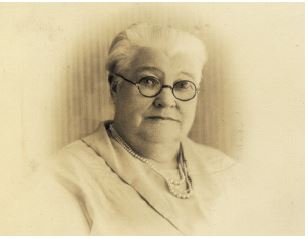 Maria Niddrie de Winter; her husband, Cornelius; and three of their children were baptized at Winnipeg in 1901. The de Winters were the first convert family in Manitoba to remain there for a time. Although some later moved to Utah, at least two of the eleven de Winter children and their families participated in the later growth of the Winnipeg Branch. This photo shows Maria in her later years. (Joybell Rowan Snarr)
Maria Niddrie de Winter; her husband, Cornelius; and three of their children were baptized at Winnipeg in 1901. The de Winters were the first convert family in Manitoba to remain there for a time. Although some later moved to Utah, at least two of the eleven de Winter children and their families participated in the later growth of the Winnipeg Branch. This photo shows Maria in her later years. (Joybell Rowan Snarr)
Elder Moore thought the de Winters would move to Utah, but they remained in Winnipeg, waiting faithfully for the return of the missionaries. This did not occur until the spring of 1906, when German E. Ellsworth, president of the Northern States Mission, sent eight missionaries to resume missionary work in the city. By November, they had distributed thousands of tracts and at least six hundred copies of the Book of Mormon, which was in keeping with Ellsworth’s conviction that the Book of Mormon was the key to conversion.[22] It had an impact. Although no one had been baptized at that time, “hundreds” were investigating, and the elders hoped that by spring a flourishing branch of the Church would be established.[23]
The First LDS Meetinghouse in Manitoba
There was good reason in 1906 to be optimistic about the future of the Church in Winnipeg. A number of changes had occurred in the character of the city that boded well for missionary efforts. News items on Mormonism had become more positive in the five years since the previous mission had closed the area in 1901. Much of this favourable press was due to the success of the Mormon colonies in southern Alberta, which were setting the pace for agricultural innovation on the prairies.[24] A spinoff from this increased attention was a less prejudiced examination of the culture and religion of the Latter-day Saints. In addition to such encouraging reports, the missionaries also benefited from a rising spirit of ecumenism among the leading Protestant churches that prompted greater tolerance of other faiths.
Certainly, the Mormon cause was aided by a better-informed public that was increasingly willing to accept cultural and religious differences, but demographics probably had an even greater impact. Winnipeg was growing rapidly. Thousands of immigrants from Great Britain and other parts of Europe were joining arrivals from eastern Canada and the United States so that the population grew from 42,340 in 1901 to 136,035 in 1911. [28] Many of the newcomers were ripe for conversion.
This, then, was the Manitoba into which the missionaries were thrust in 1906. Their work was not without challenges. After selling hundreds of copies of the Book of Mormon in Winnipeg during July and August, the missionaries discovered that a city ordinance required them to purchase a vendor’s licence to sell books. In response, they gave them away, asking instead for a donation to buy more copies.[29] During September and October, opposition from the Reorganized Church led to a sharp exchange in the Manitoba Free Press. The publicity got people’s attention and aided the missionaries as they distributed tracts and conducted street meetings.[30] Maria de Winter, who had recently become a widow, and her older children were the only Church members in the city at the time. When the first baptismal service was held on 3 July 1907, four of Maria’s younger daughters and Victoria Whitney Morgan, a middle-aged music teacher, became members of the Church.[31]
There were no baptisms in 1908, but “many friends and a number of investigators gathered with the Saints” at an April conference in the Maccabees Hall.[32] By October, a congregation was meeting regularly at 215 Nena (later Sherbrooke) Street, and Elder W. W. Parrish, president of the Manitoba Conference, was acting as branch president.[33]
The Saints continued to meet regularly throughout 1909 on Nena Street, but for the 12 May semiannual conference of the Church, they rented the larger Fairbairn’s Hall, on the corner of Main and Selkirk, to accommodate additional friends and investigators. Interest in the Church was definitely growing. Among the converts in 1909 was an English immigrant named Arthur Brewster, a clerk in a dry goods store, who was baptized in March and became the first Sunday School superintendent in May, with John de Winter and Victoria Morgan as assistants.[34] The shift from missionary to local leadership continued in 1910. Herbert Henry Denner, another English immigrant and friend of Brother Brewster, was baptized on 15 May 1910, and two weeks later, he was called by the mission president, German E. Ellsworth, to be president of the fledgling branch, with Arthur L. Brewster and John de Winter as counselors.[35] Other converts in 1910 included John and Mary Jane Shewell and their eldest daughter, Lizzie, who shortly became the wife of President Denner. By the end of the year, ten converts had been added to Church records, so there was plenty to celebrate at the Christmas party held on 26 December. Elder Newell Call, president of the Manitoba Conference, reported that there were sixty people at the evening’s event, which included a Christmas tree, a visit from Santa, some refreshments, and “an entertaining program” enjoyed by all.[36]
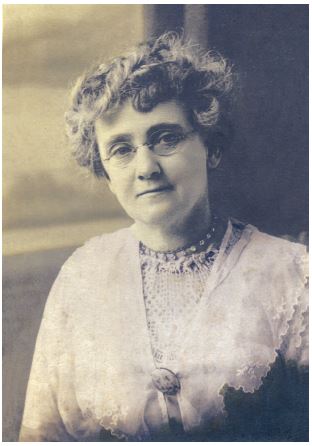 Victoria Whitney Morgan joined the LDS Church at Winnipeg in 1907. Born to a well-to-do family in Ontario, Morgan was well educated and an accomplished musician whose musical talents were much needed in the little branch. It was her influence that brought Emily Green and others of the Green family into the Church. Victoria’s husband, Sherman, although he did not join the Church, gave full support to Victoria’s active participation in Church activities. (Margaret Purdy)
Victoria Whitney Morgan joined the LDS Church at Winnipeg in 1907. Born to a well-to-do family in Ontario, Morgan was well educated and an accomplished musician whose musical talents were much needed in the little branch. It was her influence that brought Emily Green and others of the Green family into the Church. Victoria’s husband, Sherman, although he did not join the Church, gave full support to Victoria’s active participation in Church activities. (Margaret Purdy)
In 1911, more local members were called to leadership positions. This move was encouraging to the members, who also began to think of acquiring a meetinghouse of their own, a desire they conveyed to President Ellsworth in August. They even began to look for a suitable location on which to build. In the meantime, they needed a larger meeting hall because the Sunday School was “thriving” and attendance was growing to the point that current facilities were inadequate.[37] The missionaries worked hard to sustain this growth, although their efforts were sometimes challenged by negative newspaper reports that continued to be printed from time to time.[38] Yet, in spite of this opposition, seven additional converts were baptized by the end of the year.
Some converts were led to the Church because of opposition or challenges. Minnie Purdy was shocked at the magnitude of the tragic sinking of the Titanic in April 1912. She wondered what would become of those lost souls. And what of her family members who had passed on? These and other questions had bothered her for some time, and she had asked her minister about them, but his reply had been, “Just believe, even if you don’t understand.” After reading the report of the Titanic tragedy, she knelt in prayer and began again to pour out her questions to God: “What happens when people die? Where do they go? Will I ever see my loved ones again?” She was still deep in prayer when a knock came at the door. Rising, she hastened to answer it, but as she put her hand on the doorknob, she felt a shock go up her arm and through her body. Simultaneously, a voice spoke to her, saying, “The answer to your prayer is on the other side of the door.” Opening it wide, she saw standing before her two well-dressed men in bowler hats, who introduced themselves as missionaries of The Church of Jesus Christ of Latter-day Saints. “Wonderful,” she thought, “That tells it all,” but when they added, “Commonly known as the Mormons,” she shot back in dismay, “Where are your horns?” Her minister had warned his congregation that anyone who joined the Mormons grew the devil’s horns. Unruffled, the taller of the two missionaries made a deep bow and with a flourish of his hat replied, “Ma’am, we’re not wearing any today.” Perhaps it was the humour or the urgency of her queries that prompted Minnie to invite the missionaries to return when her husband was home. In subsequent meetings, they were able to answer the questions she had posed to the minister, and many more besides. Though Minnie was soon converted, her husband, James, took longer to make up his mind, and it would be four years before she and her family were baptized.[39]
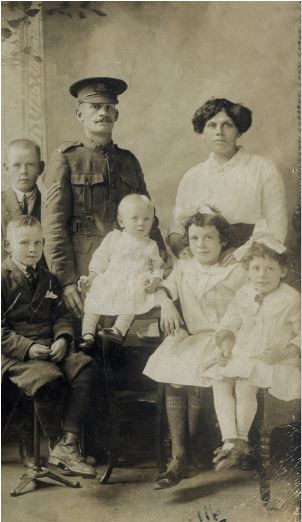 This picture of the Purdy family was taken in May 1916, shortly before the parents and older children were baptized. Back row, left to right: James Purdy Jr., James Purdy Sr., in his army uniform, and Wilhelmina Mikulecky Purdy. Front row, left to right: Clarence Purdy; Harold Purdy, supported by his father; Wilhelmina “Minn” Purdy; and Pearl Purdy. Margaret, the youngest child, was born later in the year. (Margaret Purdy)
This picture of the Purdy family was taken in May 1916, shortly before the parents and older children were baptized. Back row, left to right: James Purdy Jr., James Purdy Sr., in his army uniform, and Wilhelmina Mikulecky Purdy. Front row, left to right: Clarence Purdy; Harold Purdy, supported by his father; Wilhelmina “Minn” Purdy; and Pearl Purdy. Margaret, the youngest child, was born later in the year. (Margaret Purdy)
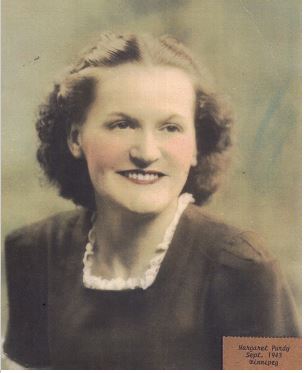 Insert, Margaret Purdy, September 1943. (Margaret Purdy)
Insert, Margaret Purdy, September 1943. (Margaret Purdy)
In the meantime, Minnie and her children began to attend church services with the Saints, whose numbers continued to grow through local baptisms and the arrival of members from overseas.[40] At Teulon, the missionaries discovered the Larson family, immigrants from Sweden who had been out of contact with the Church for twelve years but had remained “strong in the faith.”[41] Church organization also expanded with the creation of the Mutual Improvement Association in January and the Relief Society in September.[42] By the end of the year, there were upwards of eighty members and investigators in the branch, many of whom gathered for the annual Christmas program on 25 December 1912 at 932 Sherbrooke Street, where the Saints were now meeting. The richly decorated hall included a Christmas tree and presents, which were distributed to all the children after the program had been rendered and lunch served. It was a memorable event for everyone involved.[43]
By April 1913, the members had intensified their search for a site on which to build a chapel, and in May the mission purchased for that purpose “the fifth lot west of Arlington St. on Winnipeg Ave.”[44] Construction could not begin immediately because the mission was building two other chapels in Chicago; nevertheless, the Saints in Winnipeg expected their building to be constructed in 1914.[45] In the meantime, they continued to meet in the hall on Sherbrooke and to conduct baptismal services either at the Turkish baths in the Travellers Building or at the Red and Assiniboine Rivers.
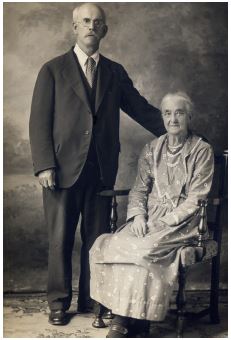 Herbert W. Cliffe and his wife, Jane Elizabeth Horsfall. The Cliffes were English immigrants who were pioneers in the Winnipeg LDS branch at 903 Winnipeg Avenue. Their eldest daughter, Eliza, was the first to join the Church in 1910, followed by her parents in 1911 and 1913. Eliza later married missionary Joseph Lorenzo Peterson in the Salt Lake Temple. A granddaughter of Jane Cliffe, Annie Kitchen, was another faithful member, who married William Banks. It was people like these that kept the tiny LDS congregation alive in the early days of the Church in Manitoba. (Margaret Purdy)
Herbert W. Cliffe and his wife, Jane Elizabeth Horsfall. The Cliffes were English immigrants who were pioneers in the Winnipeg LDS branch at 903 Winnipeg Avenue. Their eldest daughter, Eliza, was the first to join the Church in 1910, followed by her parents in 1911 and 1913. Eliza later married missionary Joseph Lorenzo Peterson in the Salt Lake Temple. A granddaughter of Jane Cliffe, Annie Kitchen, was another faithful member, who married William Banks. It was people like these that kept the tiny LDS congregation alive in the early days of the Church in Manitoba. (Margaret Purdy)
Missionary work was occurring outside of Winnipeg as well, and although members were few and far between, the elders travelled the countryside during the summer months in search of converts. On one such tour of southwestern Manitoba in 1913, they taught and baptized Chief Sitting Eagle of the Pipestone Reserve, who became the first of the Dakota people in Manitoba to accept the restored gospel of Jesus Christ.[46] Years later, he explained through an interpreter that he had been “sick, very sick and that the elder who had converted him, H. Joseph Packer, had lived with him three days after which he recovered as a result of the administration of the Priesthood, and was baptized.”[47] His wife joined the Church in 1914, but, in spite of Chief Sitting Eagle’s desire for missionaries to teach his friends and relatives on the reserve, government restrictions prevented this from happening.[48] Nevertheless, he often travelled to Winnipeg to meet with the Saints and remained faithful throughout his life.[49]
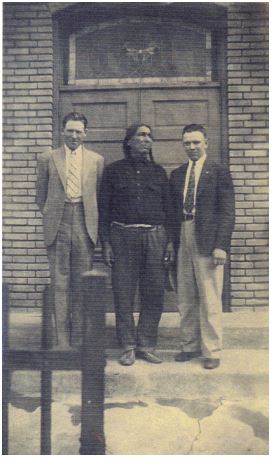 This photograph of Chief Sitting Eagle was taken in front of the chapel at 903 Winnipeg Avenue. The other two individuals are unidentified but may be the missionaries who baptized him. (Margaret Purdy)
This photograph of Chief Sitting Eagle was taken in front of the chapel at 903 Winnipeg Avenue. The other two individuals are unidentified but may be the missionaries who baptized him. (Margaret Purdy)
The missionary successes of 1913 were certainly encouraging, but there were other reasons for optimism, too. Local Saints were excited over news that construction had begun on the Cardston Temple, an undertaking reported in the local newspapers throughout the year.[50] Equally exciting was the prospect of their own chapel. Supervision for the construction of this building was assigned to James C. Cahoon, an Alberta contractor and former president of the Chicago Conference, who had already overseen the construction of the first LDS chapel in “the Windy City.” Arriving in February 1914, he immediately set to work, and by the middle of March, excavation of the basement had begun at 903 Winnipeg Avenue, with most of the work being done by the local members. Building proceeded rapidly, and the chapel was sufficiently constructed by 31 May to commence services.[51] When finally finished, it boasted a baptismal font, some living quarters for missionaries in the basement, and a seating capacity of two hundred. Over the main entrance on the south side of the building, it also had several stained glass windows depicting the Bible and the Book of Mormon. It was dedicated by Orson F. Whitney of the Quorum of the Twelve Apostles on 30 August 1914 in three sessions, each attended by approximately 150 people, becoming the first LDS meetinghouse in Canada outside of Alberta.[52]
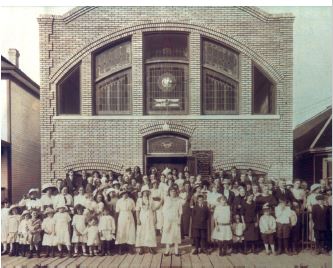 This photograph was taken on Sunday, 31 August 1914, at the dedication of the first LDS lhurch building in Manitoba at 903 Winnipeg Avenue. Chief Sitting Eagle is in the back row, immediately to the right of the entrance. James Purdy, holding his daughter Pearl, is second to the left of Sitting Eagle. Purdy’s wife, Wilhelmina Mikulecky Purdy, is standing next to her husband. (Margaret Purdy)
This photograph was taken on Sunday, 31 August 1914, at the dedication of the first LDS lhurch building in Manitoba at 903 Winnipeg Avenue. Chief Sitting Eagle is in the back row, immediately to the right of the entrance. James Purdy, holding his daughter Pearl, is second to the left of Sitting Eagle. Purdy’s wife, Wilhelmina Mikulecky Purdy, is standing next to her husband. (Margaret Purdy)
Among those baptized in the new meetinghouse in 1914 were Harry and Annie Pruden, who would become pillars of the Winnipeg Branch. Harry had the distinction of being the first member of the old Hudson’s Bay Company families to join the Church, he being a direct descendant of Chief Factor John Peter Pruden and his Cree wife, Patasegawisk.
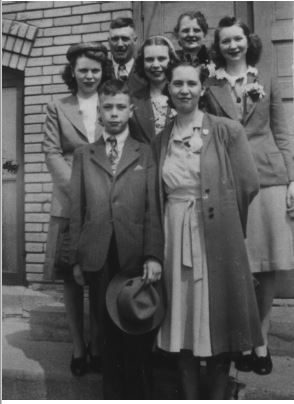 The Harry Pruden family at 903 Winnipeg Avenue, May 1944. Back row, left to right: Harry and his wife, Annie Palmer Pruden. Middle row, left to right: daughters Marjorie (Berthman), Mildred (Hamon), and Dorothy (Boittiaux). Front row, left to right: son Harold John Pruden and daughter Edith (Eburne). (Margaret Purdy)
The Harry Pruden family at 903 Winnipeg Avenue, May 1944. Back row, left to right: Harry and his wife, Annie Palmer Pruden. Middle row, left to right: daughters Marjorie (Berthman), Mildred (Hamon), and Dorothy (Boittiaux). Front row, left to right: son Harold John Pruden and daughter Edith (Eburne). (Margaret Purdy)
The completion of the chapel in 1914 was encouragement enough to keep many Church members in the city; however, for others the pull to Utah was compelling. It was Zion, the place of gathering for the Saints, the home of the prophet, and a sanctuary from an unbelieving world. Moreover, temple blessings were already available there.[53] Between 1913 and 1920, at least seven active families left for Salt Lake City, an exodus that slowed the development of local leadership in the Church.[54] However, the decision broadened opportunities for the departing families, among them the Jaffas, who left for Utah in 1913. Four generations later, their numerous descendants continue to serve in wards and stakes, in the mission field, and in the temple.[55]
In the meantime, despite the losses to greener pastures, the Church in Manitoba continued to grow slowly. During World War I, Manitoba benefited from an influx of missionaries reassigned from Europe to North America, and by 1915, it also had its first sister missionaries, Fern Green and Lorana Smith, who were serving in Winnipeg.[56] On the other hand, the war had less welcome side effects. Potential investigators were often too preoccupied by war news to listen to the missionaries, and several “energetic members” left the branch to serve in the army.[57] Still, Elder W. R. Christensen reported in August that he and Elder Sam Burke had visited Camp Hughes, about 160 kilometres west of Winnipeg, where about thirty thousand recruits were training for the European war. They spoke to a number of soldiers who were interested enough to accept a quantity of Church literature from them.[58]
The challenges of World War I were certainly real, but branch members and the missionaries made the best of them. They were encouraged by regular visits from President Ellsworth, and in July 1915, George Albert Smith of the Quorum of the Twelve Apostles preached at a conference to “the largest Mormon audience ever collected in Winnipeg.”[59] Later that year, the Relief Society women prepared and submitted the names of twenty-five ancestors to receive temple ordinances, a work further encouraged during a visit in 1917 by President E. J. Wood of the Alberta Stake, who spoke to the members concerning the Cardston Alberta Temple, then under construction.[60]
In December 1918, the Manitoba Saints received word that all eight of the men from the Winnipeg Branch who had served in France were “alive and well.”[61] Although some of the men had been wounded, it was considered a “miracle” that all had survived.[62] Sadly, there were hidden costs for returning soldiers, including loss of health and family relationships, to which the LDS men were not immune.[63] They also came back to a city that was ravaged from October 1918 to April 1919 by Spanish flu, a pandemic that their compatriots had brought back from Europe. Although there is no evidence that any of the LDS soldiers or local members perished as a result of the pandemic, over fourteen thousand people in Winnipeg were infected, and a thousand or more died. If this was not enough, the soldiers faced poor economic conditions that contributed to the famous Winnipeg General Strike, which shut down the entire city in May and June of 1919.
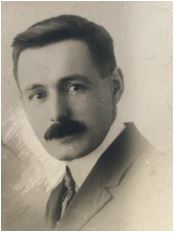 Robert Gerber. (Winnipeg Manitoba Stake)
Robert Gerber. (Winnipeg Manitoba Stake)
In August 1919, the Manitoba Conference was transferred to the newly created Canadian Mission, with headquarters in Toronto, and President Ellsworth and his wife were also released, having served faithfully for fifteen years in the Northern States Mission. With their departure, an era had come to an end.
Between the Wars
Nephi Jensen, the new president of the Canadian Mission, made two visits to Winnipeg in 1919 to organize the work of the conference, and by October 1920, there were ten missionaries serving in Manitoba, including John G. Allred as conference president and his wife, Harriet, of Raymond, Alberta, who would remain in Winnipeg for three years.[64] In March 1920, the Sunday School was reorganized, and A. Stanley N. Roberts was appointed Sunday School superintendent, replacing George Grayson, who had moved to Utah.[65] Two years later at the March conference, Roberts was set apart as branch president, the first local member to serve in that calling since 1913, a position he would hold for the next twenty-seven years.
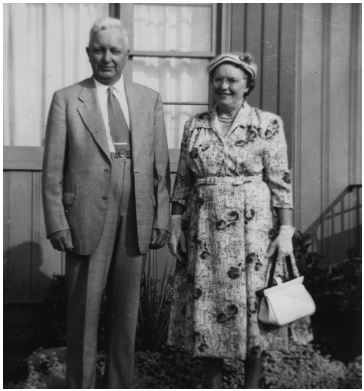 Stan and Nellie Roberts, 1955. Stanley Roberts, who had joined the Church in England before immigrating to Canada, served as president of the Winnipeg Branch from 1922 to 1949. (Doreen McBeath)
Stan and Nellie Roberts, 1955. Stanley Roberts, who had joined the Church in England before immigrating to Canada, served as president of the Winnipeg Branch from 1922 to 1949. (Doreen McBeath)
In the early 1920s, a few more families left for Utah or Alberta. Fortunately, missionary efforts continued to bring in new converts who helped fill the gaps left by the departing Saints. Alan Halsted became a member of the Church in 1923 after attending street meetings in downtown Winnipeg. Apparently given to atheistic views, he was first inclined to heckle, but eventually his prejudices weakened as he opened his ears and his heart. Once converted, Halsted served in the branch for five years before becoming a missionary himself, the first from the Manitoba District.[66] He was set apart in June 1928 by a visiting Apostle, Elder David O. McKay, and served in Saskatchewan.
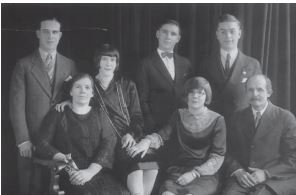 The family of Olga Puhan Arlt. Standing, left to right: sons Ralph, Henry, and Edwin. Seated in front, left to right: Olga Arlt, daughters Lily and Edith, and husband, Herman Arlt. Sister Arlt was a faithful member of the 903 Winnipeg Avenue LDS congregation all her life. (Margaret Purdy)
The family of Olga Puhan Arlt. Standing, left to right: sons Ralph, Henry, and Edwin. Seated in front, left to right: Olga Arlt, daughters Lily and Edith, and husband, Herman Arlt. Sister Arlt was a faithful member of the 903 Winnipeg Avenue LDS congregation all her life. (Margaret Purdy)
Meanwhile, events were unfolding in northwestern Ontario that would have an impact on Manitoba. In early summer 1924, Joseph Quinney Jr., the new president of the Canadian Mission, received a letter from Salt Lake City making inquiries about an LDS family named Olson, whose relatives in Sweden were trying to locate to North America.[69] They had converted a few years prior to immigrating to North America and were living at a place named Bergland, somewhere in northwestern Ontario. President Quinney brought the letter to the attention of the elders stationed at Port Arthur (now Thunder Bay), Ontario, who acted at once. After locating Bergland on the map, in a remote section of the country 447 kilometres west of Port Arthur, Elders Alvin D. Wilson and Arthur C. Whiting set out along the railroad track to visit the Saints there. It took them four days by foot and train through forest and wilderness before they finally reached their destination, but it was well worth it. They received a joyous welcome and were able to hold several well-attended meetings at a local school and church during the next few days. On subsequent visits to the community, they began to perform baptisms, and the members started to dream of a meeting place of their own. With a donation of $250 authorized by Salt Lake City, land donated by Godfrey Olson, and timber hewn by their own hands, the Saints did build a chapel, the second in Canada outside of southern Alberta. It was dedicated on 20 November 1925 by John G. Allred, the same man who had previously served a mission with his wife in Winnipeg and who was now president of the newly created North Central States Mission to which Bergland had been assigned.[70] The dedication heralded a bright future for the area. With a nucleus of two large families, those of brothers John and Christian Olson, the little branch would expand to include many other families. It would also influence the expansion of the Church in northwestern Ontario at such places as Kenora, Fort Frances, Dryden, and Atikokan, all because of a letter and two missionaries willing to trek 450 kilometres in search of Saints.
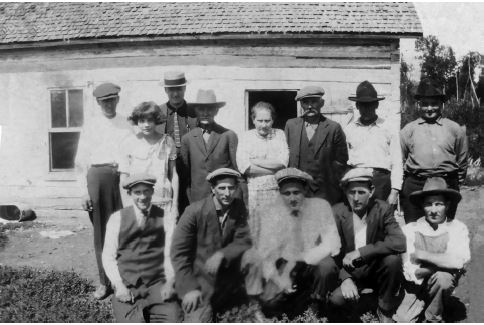 First LDS meeting held at Bergland, Ontario, August 1924. Front row, left to right: Albert Olson, John Halverson, Gottfred Olson, Andrew Olson, and Peter Halverson. Back row, left to right: Alice Olson; Christian Olson; Christina Olson and her husband, John Olson; Carl H. Olson; and John Erickson. Elder Alvin Wilson is at the back. (Caroline Jensson Gate)
First LDS meeting held at Bergland, Ontario, August 1924. Front row, left to right: Albert Olson, John Halverson, Gottfred Olson, Andrew Olson, and Peter Halverson. Back row, left to right: Alice Olson; Christian Olson; Christina Olson and her husband, John Olson; Carl H. Olson; and John Erickson. Elder Alvin Wilson is at the back. (Caroline Jensson Gate)
The situation in rural Manitoba was not as encouraging. Although missionaries continued to travel outside of Winnipeg to urban centres like Brandon, Selkirk, and Portage la Prairie during the 1920s and 1930s, such visits were sporadic, and they never resulted in enough new members to organize permanent congregations.[71] Instead, the converts they did make either moved to where the Church was organized or drifted away. Farm country was equally challenging. Elizabeth Poole of Springhill, just a few kilometres outside of Neepawa, was already a member of the Church in Great Britain when she married a Canadian soldier named Walter D. Poole and immigrated to Canada in 1919. She had to wait until August 1923 for missionaries to teach and baptize her husband and bless her two older children and a further six years before Elders Wagstaff and Bushnell came and blessed her two younger children.[72] After 1929, the elders maintained contact with the Pooles at least once a year, except for 1938, but with the outbreak of World War II in 1939 and a corresponding reduction in the number of missionaries entering the field, such visits ceased. In time, Church ties slipped into memory or were forgotten altogether. Indeed, when Sister Poole’s elder son, Elmer, was baptized at Brandon in 1977, he remembered the missionaries’ visits from his childhood, but he did not know that his parents had been members of the Church, a testament to how quickly knowledge can be lost when not reinforced.
Still, the seeds of the gospel had been planted, and they bore fruit long after the missionaries had gone. During visits to the Springhill District in 1929 and 1930, Elder Wagstaff and his companion also taught the Adrian “Johonson” family. Wagstaff recalled discussions with the mother, who read the scriptures and asked many questions. Nevertheless, when his mission ended, she still had not been baptized, and he returned home feeling disappointed that he had been unable to bring her and others he had taught into the Church. Years later, while he and his wife were attending a missionary reunion in 1969, a woman came up and identified herself as a daughter of that farm wife he had taught long ago in Manitoba. In her hand she had a worn copy of the Book of Mormon that he had given her mother forty years earlier. She then told him that about sixty members of her family were now members of the Church, including a branch president.[73] The seed Elder Wagstaff had planted was now a tree with many branches.
Although missionary success was often hard to see in rural Manitoba during the Depression, the missionaries in Winnipeg continued to bring new people into the congregation at “903.” Since a lay church requires considerable sacrifice in terms of time and resources, every new member was a welcome addition to the small nucleus of faithful Saints already engaged in the cause. Together they organized and conducted church meetings, participated in choirs, held bazaars and bake sales, and performed in musical theatre as well as in variety shows and concerts.[74] A typical Sunday began with President Roberts welcoming the members as they entered the chapel for the Sunday School meeting at 10:00 a.m., the children taking their places in the front pews, with their teachers and the older members behind them. Brother Cliffe, the Sunday School superintendent, who was much loved for the peppermints he always had in his pocket, began the meeting in his broad Yorkshire accent, which was a continual delight for the children.[75] After opening exercises, which included the blessing and passing of the sacrament, the children got up and walked in order of age to their classrooms in the lower level of the chapel while the adults remained behind for their lesson. The sacrament meeting was held at 7:00 p.m., as typified by a service conducted on 20 May 1923 by John Simpkin, second counselor in the branch presidency. There were four hymns, two sung by the congregation and two by the choir. The sacrament was administered by Charles Batt and James Barton and passed by Clarence Purdy and James Warrington. President Roberts announced the upcoming Relief Society bazaar and program to be held later that week. Talks were given by Brother Simpkin and the missionaries, Elders Nelson Hansen and Morgan Pitcher, with prayers by Robert Gerber and Stanley Roberts. There were forty-eight adults and seventeen children present for a total of sixty-five.
By 1930, there were 197 members in the Manitoba District, which was now under the leadership of Arthur D. Welling, who had replaced John G. Allred a year earlier as president of the North Central States Mission.[76] Welling took over in difficult times. The stock market crash of 1929 ushered in the Depression and massive unemployment all over North America, including Winnipeg, which had never fully recovered from the economic decline in the decade after the 1919 general strike. Yet in 1930, the Winnipeg Saints remained active and optimistic, holding a well-attended Sunday School picnic at Assiniboine Park in August, their first Primary conference in September, and a three-act play in December entitled Betty, the Girl of My Heart.[77] The missionaries were busy, too, and especially so during the summer months, when they worked in rural Manitoba. They also conducted street meetings in Winnipeg. Despite some opposition, the work continued unabated, and seven investigators were baptized at the September quarterly conference presided over by George Albert Smith of the Quorum of the Twelve.[78]
At the centre of this little group of converts was Frederica Bunnage, a natural-born leader who had shepherded five of her children and a boarder named Mary Huht into the Church. Sister Bunnage first become interested in the gospel after renting out rooms to the missionaries, whose bearing and character impressed her so much that she was open to their message. Once converted, she was fully committed. In July 1932, just nine months after her baptism, she and Ellen Roberts were called to be “special missionaries to labour in the Manitoba District and assist the regular missionaries in spreading the gospel,” a pressing need as there were fewer missionaries entering the field because of the depressed economy.[79] Her efforts proved successful when her cousin Norma McConochie joined the Church at Portage la Prairie in January 1933, a baptism which shortly led to the conversion of other members of that family.
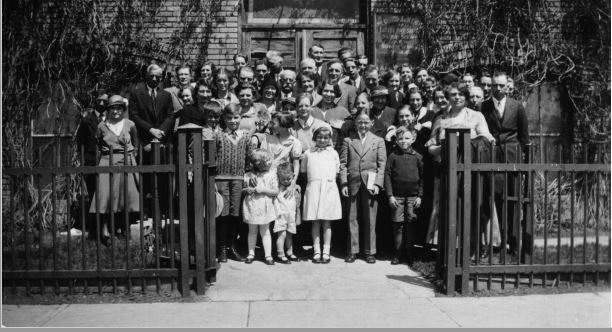 The congregation of 903 Winnipeg Avenue (ca. 1937). Wilhelmina Purdy is standing at the extreme right of the picture on the front row. The shorter woman on the extreme left in the front row is Martha Ogden, a faithful English convert.[80] (Margaret Purdy)
The congregation of 903 Winnipeg Avenue (ca. 1937). Wilhelmina Purdy is standing at the extreme right of the picture on the front row. The shorter woman on the extreme left in the front row is Martha Ogden, a faithful English convert.[80] (Margaret Purdy)
For the less fortunate at this time, including Church members and missionaries alike, economic uncertainty created financial challenges that were almost insurmountable. In such cases, the Lord often intervened. In one instance, when James Purdy needed a helper to assist him with a job, Sister Purdy suggested a missionary. Unknown to either of them, a young elder was just then praying in earnest for something to eat. The job was an answer to his prayer, and he later spoke of it in a sacrament talk entitled “God Moves in a Mysterious Way.”[81] When the Treftlin family lost all their possessions in a fire, one of the Purdy daughters was able to get clothing for all the family through a generous friend at the Hudson’s Bay store downtown.
Everyone was poor, but the Saints managed to feed themselves as well as others worse off than they were. Sometimes it was on short notice, like the time Sister Purdy was asked by the missionaries to provide a wedding breakfast the following day for Cecil Gate and Mabel Broman of Bergland, who had come up to Winnipeg for his baptism and their marriage. At another time, the sisters collected clothing for the Saints at Bergland, which a railroad agent, smitten by the pleas of a pretty young missionary, shipped free of charge.[82]
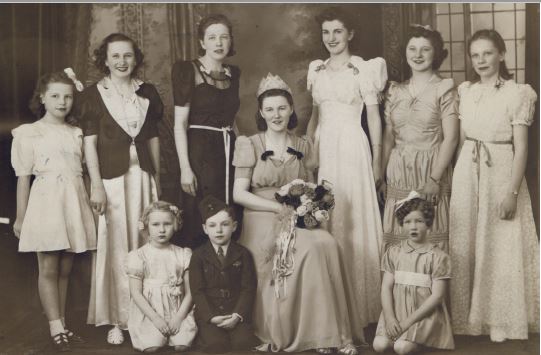 Gold and green ball, Winnipeg, 1941. Gold and green balls were a regular feature of the Latter-day Saint social calendar in Winnipeg. Standing, left to right: Edna Favel, Wilma Bunnage, June Batt, Clem Clark, Helen Favel, and Elva Martin; seated in centre: Iris Batt; kneeling in front, left to right: Carolyn Eburne, Tom Jack, and Doreen McBeath. (Doreen McBeath)
Gold and green ball, Winnipeg, 1941. Gold and green balls were a regular feature of the Latter-day Saint social calendar in Winnipeg. Standing, left to right: Edna Favel, Wilma Bunnage, June Batt, Clem Clark, Helen Favel, and Elva Martin; seated in centre: Iris Batt; kneeling in front, left to right: Carolyn Eburne, Tom Jack, and Doreen McBeath. (Doreen McBeath)
In spite of their challenges, the Saints could look forward to apostolic visits at least once a year during the 1930s.[83] In June 1934, Elder Melvin J. Ballard attended district conference accompanied by Wilford W. Richards, the new mission president.[84] On his return to Manitoba in 1937, Elder Ballard spoke at district conference and introduced David A. Broadbent, the incoming mission president replacing Elder Richards. While in the city, Ballard was interviewed by a Free Press reporter, who described the Apostle as “chairman of the Mormon church relief activities” and noted “that great success has attended their efforts in reestablishing thousands of their church members who were on relief.”[85] Such measures to counter the effects of the Depression were of great local interest.
For the Saints in Winnipeg, Church activity provided a welcome respite from worry over the economy. They continued to organize annual Christmas concerts, plays, bazaars, choirs, and other activities, including a successful gold and green ball in 1936, which became a regular event on the branch calendar.[86]
At the end of December 1937, there were 252 members in the Manitoba District, including 150 in the Winnipeg Branch, as well as six missionaries, whose work was primarily confined to Winnipeg, Brandon, and rural Manitoba. In March 1938, President Broadbent instructed all the elders to move to the Rainy River District of northwestern Ontario, where they were to remain for several months
By December 1938, two missionaries were assigned again to the city, with the remaining six divided evenly between Kenora and Fort Frances, Ontario, and International Falls, Minnesota.[90] However, all the district missionaries gathered in Winnipeg in May 1939 for the royal visit of King George VI and the future Queen Elizabeth II, who were on an official tour of Canada. During the parade that followed on May 24, the elders were part of the official contingent of guards along the route, doing their duty and “a little missionary work” at the same time.[91] It was a festive time in Winnipeg, as citizens came out to celebrate and cheer the royal couple, but dark clouds were on the horizon. On 6 September, Great Britain declared war on Germany, and Canada followed suit on September 10. Twenty years had come and gone since the end of World War I, and again the world was plunged into a worldwide conflict. Its impact on the Saints would not be long in coming.
World War II and the Postwar Era
The first impact of the war was the transfer of four missionaries from Europe to the Manitoba District, bringing its total to twelve by June 1940, with four being assigned to Winnipeg, which was again the mission headquarters.[92] This was short lived. Although the United States did not enter the conflict until the attack on Pearl Harbor in December 1941, its preparations began in 1940 with an increase in the size of the armed forces. Consequently, as more and more young LDS men were drafted, fewer entered the mission field. By 1941, the Manitoba District was shifting its few missionaries back and forth between Winnipeg and the Rainy River District, with headquarters sometimes in Winnipeg and at other times in Fort Frances, Ontario, where missionary opportunities had become promising.[93] Gertrude and Delaine Shine were the first baptisms in Fort Frances in June 1941, with their parents following them in September. J. Orville Shine was the only priesthood holder at the time, and he became the branch president. His wife, Ethel Bastedo Shine, became the Relief Society president. Soon other converts were added to form the nucleus of the Fort Frances Branch, which continues to this day.[94]
Back in Winnipeg, the local Saints responded to the shortage of missionaries by doing more to spread the gospel themselves. This contributed to a growth in Church membership during the war, although the increase was offset somewhat by the loss of young men leaving to enter military service. The decrease in the number of acting and potential priesthood holders was also a call to action. In January 1940, the men of the branch met at the home of President Roberts to discuss the improvement of ward teaching and of other regular visits to Church members as well as to organize themselves to hold weekly priesthood meetings.[95] In February, the branch held the first in a series of monthly classes on genealogy and temple work.[96] In March, a reorganization occurred in the Relief Society because of the ill health of Ellen Warrington, who had served as president for ten years. She was replaced by Delvoir McBeath, a dedicated and conscientious leader who would serve just as long.[97] It was a big job, because the boundaries of the branch extended to the edge of Winnipeg, with sisters often living a considerable distance from the Church and each other. As a result, it could take an entire day via streetcar and bus for Sister McBeath to visit all the sisters for whom she was responsible.
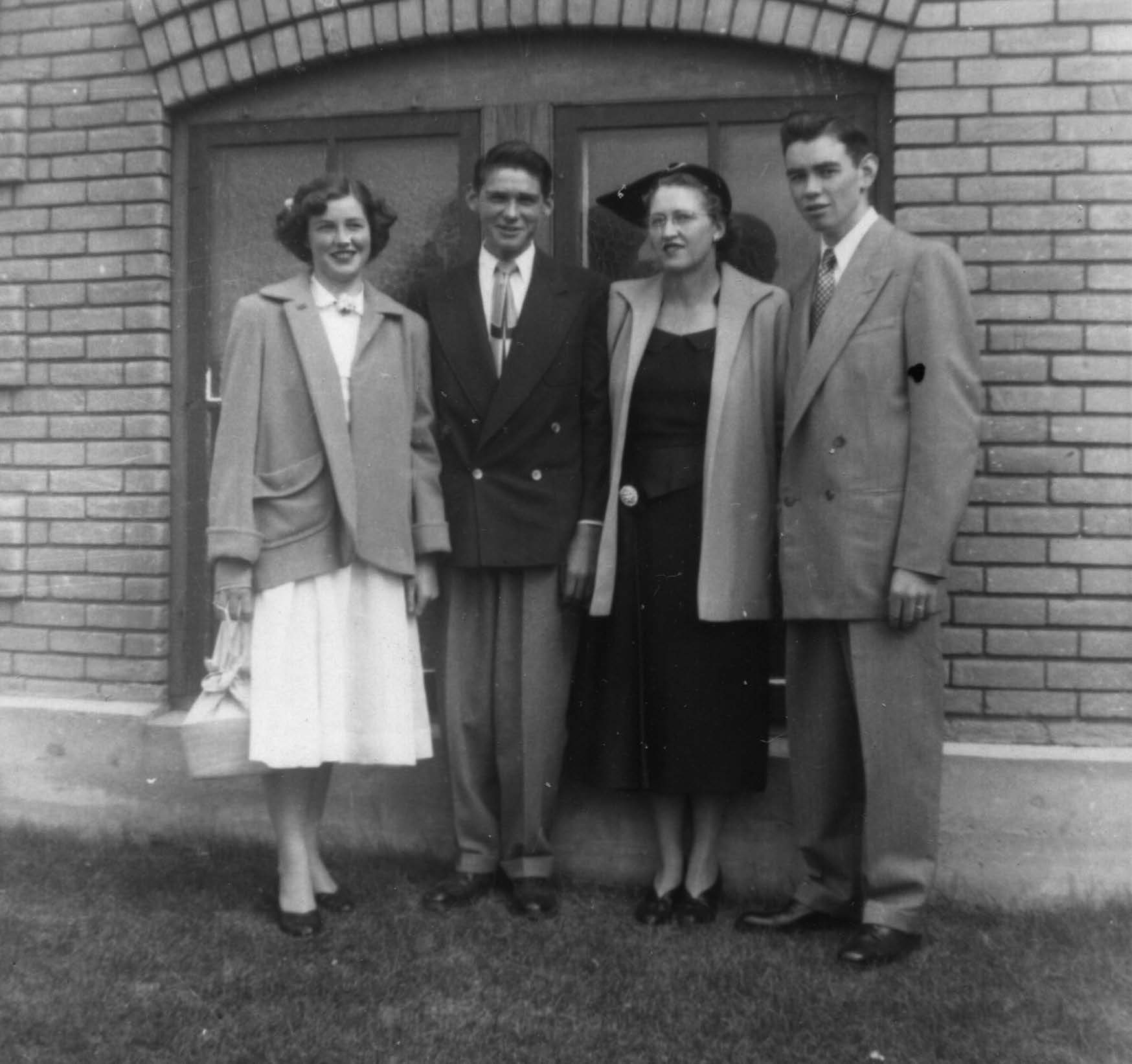 The family of Delvoir Meldrum McBeath, left to right: daughter Doreen, son Melvin, Delvoir, and son Doug, taken outside the meetinghouse at 903 Winnipeg Avenue. (Doreen McBeath)
The family of Delvoir Meldrum McBeath, left to right: daughter Doreen, son Melvin, Delvoir, and son Doug, taken outside the meetinghouse at 903 Winnipeg Avenue. (Doreen McBeath)
Public transportation and walking were the usual means of getting around during the war, even for those who had previously driven their own cars. Rationing was the reason; because gasoline and other commodities were being shipped overseas to support the troops, it became necessary to ration them at home so that everyone had some access to these scarce items. As a result, ration cards became a feature in every household. Reminders of war were everywhere, not just in the newspapers and radio broadcasts but also in the continuous decline of the missionary force. By April 1944, there were so few missionaries in the North Central States Mission that the Manitoba District was closed altogether, and for the next year and a half only two missionaries would be assigned at intervals to Winnipeg, and then only briefly.[98] The memory of World War I was also kept fresh by memorials, Remembrance Day parades, and the soldiers who were still suffering its effects. The Winnipeg Branch had its own reminder in Brother John Levers. Disfigured and halting in speech, he would shuffle to his feet on fast Sunday and stand beside Brother Eburne, who read the battered soldier’s written testimony to the congregation. His pluck was inspirational. Although broken in body, his spirit remained strong.[99]
The Church carried on as well. In June 1942, Apostle George F. Richards attended a conference at Winnipeg accompanied by his son George F. Richards Jr., the new mission president. Elder Antoine R. Ivins of the Seventy visited in September 1943, and Apostle Stephen L. Richards came in June 1945.[100] William L. Killpack, who became president of the mission in 1944, was in charge when missionary strength was at its lowest, but he also saw it rebound after the war so that by October 1946, there were sixty-eight full-time and forty local missionaries serving in the mission.[101] By 1949, John B. Hawkes was mission president, and Church membership had increased sufficiently to warrant his making changes in the leadership of the district. As a result, A. Stanley N. Roberts was released as the Winnipeg branch president in March and sustained as the Manitoba District president, the first local member to hold that position. The new branch president was Roy D. Cahoon, son of James C. Cahoon, who had supervised the construction of the first Winnipeg meetinghouse in 1914.[102]
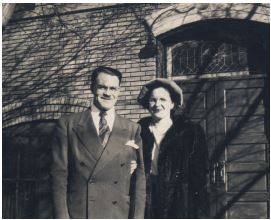 Roy and Noreen Cahoon in front of the 903 Winnipeg Avenue Chapel (ca. 1950). (Margaret Purdy)
Roy and Noreen Cahoon in front of the 903 Winnipeg Avenue Chapel (ca. 1950). (Margaret Purdy)
Within a year, the younger President Cahoon was to confront a far different challenge from that faced earlier by his father. On “Black Friday,” 5 May 1950, the rising Red River broke through its dikes, sending torrents of water downstream that destroyed four of the city’s eleven bridges and flooded large sections of the city. Not only was President Cahoon’s home inundated but also three other families in the Winnipeg Branch were severely affected by flood waters, including the Prudens, whose home was completely destroyed.[103] In response, the Church provided materials to build a new two-bedroom house for Brother and Sister Pruden and sent in labour missionaries to assist local Saints in its construction.[104]
As often happens in such cases, the project had unexpected consequences. In this instance it changed the life of Jack de Winter and his family, who lived just a couple of blocks from the building site. Although Jack had not returned to Church activity after his military service overseas in World War II, he did become involved in the construction of the Pruden house. One day, he invited the building missionaries over for a noon meal that his nonmember wife, Joan, had prepared. Already touched by the kindness of a couple of sisters from Jack’s church, she inquired about the books the missionaries had with them, and their answers led her to accept an invitation to investigate further. During one of the lessons, she suddenly felt prompted to ask the missionaries about the meaning of a dream that had troubled her for over a decade. It had occurred in England on three successive nights prior to the war, and in each instance, she woke up crying. The plot did not vary. Joan found herself in a room in a sacred place, with others dressed in white. She joined them as they moved from room to room, but at one point, she got behind. Hurrying to catch up, she saw them ahead of her starting up stairs leading to the place where she knew the Lord was. She wanted to accompany them, but something prevented her, and she woke up in tears. The missionaries did not provide an interpretation, but they promised her that she would know one day. Joan was converted soon after, and Jack returned to activity to baptize her and later provided important leadership in the branch. Some years later, when she entered the Cardston Alberta Temple for the first time, the dream was fulfilled to the letter.[105]
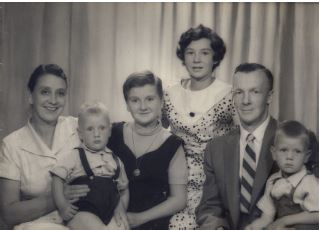 Family of Jack de Winter Jr., left to right: Joan Richardson de Winter holding son Melvin, Delia, Hazel standing, Jack de Winter Jr. holding son Brian. Jack de Winter Jr. was the son of Jack de Winter Sr. and the grandson of Cornelius and Maria de Winter. The photograph was by Corona Studio, Edmonton, 1957, after the family moved to Grande Prairie, Alberta. (Joybell Rowan Snarr)
Family of Jack de Winter Jr., left to right: Joan Richardson de Winter holding son Melvin, Delia, Hazel standing, Jack de Winter Jr. holding son Brian. Jack de Winter Jr. was the son of Jack de Winter Sr. and the grandson of Cornelius and Maria de Winter. The photograph was by Corona Studio, Edmonton, 1957, after the family moved to Grande Prairie, Alberta. (Joybell Rowan Snarr)
With the increase of missionary strength after the war, the Manitoba District began to grow, and by December 1952, the Winnipeg Branch had 253 members, including 39 recent converts.[106] Ethel May Baldwin and Roberta Jack, the first women in the district to be called as full-time missionaries, were assigned to Minnesota in the North Central States Mission.[107] Branches were organized at Portage la Prairie in February 1954, with Frederick W. Hillyer as president, and at Brandon in July 1955, where Delwin G. Harding became the first president.[108] There were significant changes in mission and district leadership at this time, too. G. Eugene England replaced John B. Hawkes as president of the North Central States Mission in 1954, and in October of that year, Roy D. Cahoon was called as president of the Manitoba District, with Jack de Winter and John Gross as his counselors.[109]
In the meantime, the chapel at 903 Winnipeg Avenue was beginning to show its age, and more importantly, it had become too small to adequately meet the needs of a growing congregation. This need had been anticipated by Milton R. Hunter of the Seventy during his visit to Winnipeg in 1946, and at his urging, local leaders had instituted a building fund.[110] By 1952, Alfred R. Youngs, the Sunday School superintendent of the Winnipeg Branch, was able to report that $4,100 had been raised for a new building.[111] Land had already been purchased at 505 Academy Road in River Heights, adding a further stimulus to local fundraising efforts that included concerts, drama presentations, Relief Society bazaars, and the sale of potatoes and chickens.[112] Finally, in May 1954, a group of Saints gathered for the groundbreaking ceremonies. Elder Oscar A. Kirkham of the Seventy gave a talk and dedicated the site, and President Hawkes, the outgoing mission president, and other local leaders turned over the first shovelfuls of sod.[113]
It would still be four long years before the new chapel was ready for dedication. In 1953, neighbouring residents had registered their opposition to its construction, based partly on the claim that the existing meetinghouse and grounds at 903 Winnipeg Avenue were not being properly maintained. That opposition subsided after President de Winter organized a priesthood work party to clean the building and tidy up the grounds, but there was only so much a good cleaning could do.[115] After Arthur Gorner became branch president in October 1954, he made repeated appeals to the Saints concerning their commitments to the building fund, undoubtedly prompted by the chapel’s obvious inadequacies.[116] Indeed, when investigator Olive Wood visited the church for the first time in 1955, she wondered why the elders had brought her to such a dingy place.[117] By 1956, the condition of the old chapel was an ever-present concern, and fundraising for the new building took on greater urgency. The lot at the new site was cleared by midsummer for construction to begin, based on plans drawn up by Alfred Youngs, and the purchase of building materials was under way. The Saints also began to organize to do the actual work. Construction proceeded slowly, but once completed in 1958, it had the distinction of being one of the last chapels built almost entirely by local members. Among the helpers were a number of nonmember husbands, such as Clive C. Northcott, who would subsequently be baptized and become president of the Manitoba District.[118]
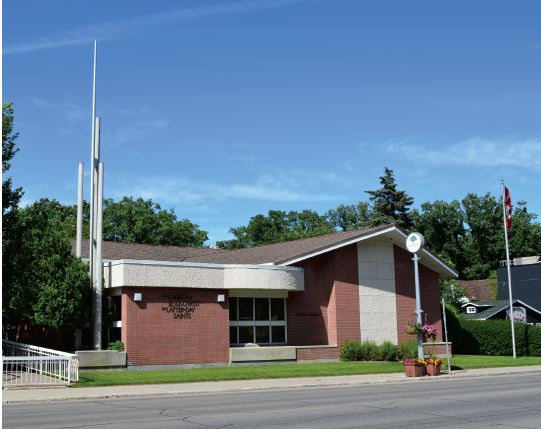 The Academy Road meetinghouse, dedicated in 1958, replaced Winnipeg’s first chapel at 903 Winnipeg Avenue. In 2016, this building housed the Wellington YSA (young single adult) Ward and the Facilities Management Group. (Kieran Shirritt-Beaumont)
The Academy Road meetinghouse, dedicated in 1958, replaced Winnipeg’s first chapel at 903 Winnipeg Avenue. In 2016, this building housed the Wellington YSA (young single adult) Ward and the Facilities Management Group. (Kieran Shirritt-Beaumont)
On 13 June 1958, Elder Harold B. Lee, who later became the eleventh President of the Church, dedicated the new meetinghouse. The dedicatory prayer acknowledged the efforts of those who raised money and laboured in the construction and noted that the building would be a great blessing to the people of Winnipeg, both Church members and members of other faiths alike. President Lee offered the building “to the Lord,” adding that “henceforth we are not owners but thy guests.” The dedication took place at a district conference, during which the new mission president, Paul C. Child, released Arthur Gorner and installed Richard Smiley as the president of the branch, with Arthur Beeston and Thomas Prodnuc as his counselors.[119] There were now 441 members in the Winnipeg Branch.[120] It had taken forty-four years for the Church to reach this number, partly because of the outflow of active Church members to stronger centres of the Church in Alberta and the United States, but the increased missionary force that became available after World War II had infused new life into the Manitoba District, and significant growth was occurring. As the 1960s approached, the future looked bright.
Expansion, Stakehood, and a Promised Temple
As the new chapel had begun to take shape on Academy, a heightened sense of purpose manifested itself among the Saints and full-time missionaries, an optimistic anticipation that friends and investigators could feel, too. Not surprisingly, this feeling translated into baptisms, the first of which occurred nearly two months prior to the dedication of the building and included George Gross; his wife, Elizabeth; and their two eldest children, a family, now in the third and fourth generation, that has remained faithful ever since. George had been brought into the Church by his brother John. Ernie Goett and Bill Rattray, the other two who were baptized that same day, also proved to be stalwart members.[121] This missionary success continued unabated, and by 1961, the branch was divided into two congregations, the Winnipeg First and Winnipeg Second Branches.[122] Illustrating the increase that was occurring, the Winnipeg First Branch grew by fifty-five and the Winnipeg Second by ninety in 1962 alone. Forty-seven members were added to the Brandon Branch, and the small branch at Portage la Prairie increased from twenty-eight to thirty-five.[123]
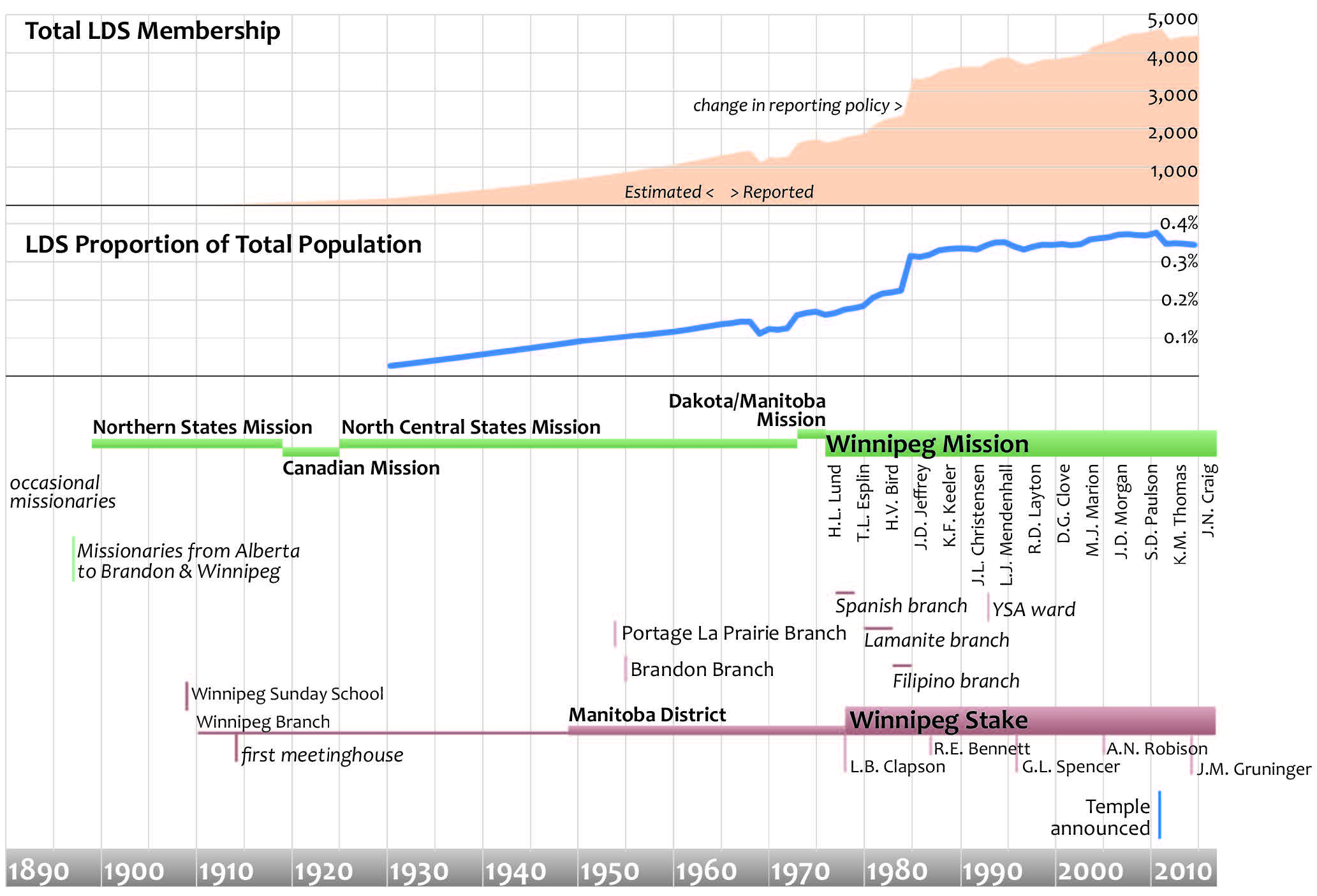
The commitment of the new Saints continued to be high. Melford R. Wilson was a retired professional football player with many achievements in a variety of sports as well as in ballroom dancing. Following his baptism in 1962, he served in several leadership roles but is probably best remembered for his work as a dance instructor. Many a youth from the 1960s to the 1980s had him to thank for any skills they acquired on the dance floor. Hans Finken was another outstanding convert. An honest, hardworking immigrant, his conversion began during World War II, when as a teenaged soldier in the German army, his life was miraculously saved not once, but several times.[124] Shortly after war’s end and his release from a Russian prisoner-of-war camp, he found his way back to his village in northern Germany, arriving starved, emaciated, and barely recognizable just six weeks before his nineteenth birthday. Nevertheless, he recovered, married, and came to Canada with his family in 1955. It was only after his conversion in Winnipeg in 1962 that he fully realized his preservation was part of a larger purpose for his life.[125]
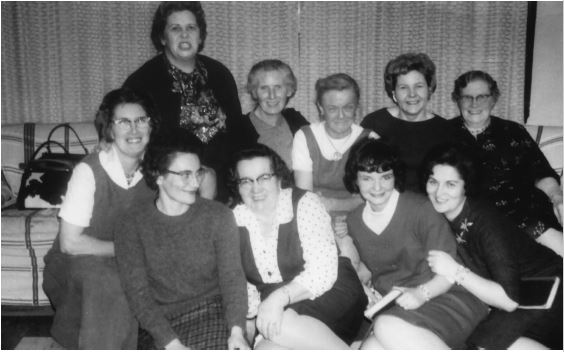 Relief Society in Selkirk, with district visitors, June 1964. Back row, left to right: Doris Youngs, Mary Brown, Ada Aitkin, Vi Slocombe, and Rosanne Beeston. Front row, left to right: Iris Rosser, Jean Prete Baty, unknown, unknown, and Barbara Goett. (Margaret Purdy)
Relief Society in Selkirk, with district visitors, June 1964. Back row, left to right: Doris Youngs, Mary Brown, Ada Aitkin, Vi Slocombe, and Rosanne Beeston. Front row, left to right: Iris Rosser, Jean Prete Baty, unknown, unknown, and Barbara Goett. (Margaret Purdy)
Not all of the increase in membership in the 1960s and early 1970s can be attributed to convert baptisms. Just as they do today, members from Alberta and elsewhere gave of their time and experience to build strong units of the Church in Manitoba. Among them were the Hillyers, who served at Portage la Prairie, Brandon, and Winnipeg; Merlin and Flora Rich, who were leaders at the branch and district levels in Winnipeg; the Spencers, who provided over thirty years of service at the ward, district, and stake level; and the Cutts family, which has a similar service record, some of whose members still live and remain active in the Winnipeg Manitoba Stake. Barbara Goett, originally from Cardston, Alberta, also left her mark through her work in the district Relief Society.[126] At that time, the local units of the Church had to raise a portion of the funds required to build new meetinghouses.[127] In her district role, Sister Goett taught the women in the branches how to make hand-dipped chocolates, and for several years these chocolates became the focus of a highly successful building-fund project.[128] However, perhaps her greater influence came through personal tragedy. In December 1965, her husband; her only son, Wayne; and his friend Ron Friesen, both recently returned missionaries, were killed in a head-on collision near Two Harbors, Minnesota, an accident that left Barbara paralyzed from the neck down. Shocked and saddened, many of the Saints turned to their scriptures to fully understand why terrible things can happen to the best of people. Sister Goett spent the next sixteen years in a Lethbridge hospital in stoic acceptance of the lot that had been given her, even serving as a Sunday School teacher to the teens from her ward across the street. Her faith in adversity inspired them and continues to inspire all those who become familiar with her story.[129]
Fortunately, there are many happier memories from the 1960s. Church services in Winnipeg started early, with priesthood meetings at 8:00 a.m., Sunday School at 10:00 a.m., and sacrament meeting at 7:00 p.m. This meant plenty of travel back and forth from the church, either by car or by public transport. The early morning bus that came along Academy Road from downtown was jokingly called “the Mormon Express,” as many people used the service. Musical instruction was a major focus of Sunday School, and under the capable tutelage of Agnes Kidd—the music director of the Winnipeg Second Branch—the congregation learned four-part harmony during music practice. She put up with no nonsense. If the Saints were a little sleepy singing the opening hymn, she would signal with a tap of her baton for the organist to stop playing and then inform the congregation that they could do much better than that. Inevitably, they did. Two-and-a-half-minute talks, usually given by the youth, were sincere, if at times unpolished. The fast and testimony meeting was generally a highly spiritual event, but occasionally it could falter on a faux pas. However, such instances were infrequent; indeed, nothing could surpass the quiet reverence of an evening sacrament meeting at the chapel on 505 Academy Road, with the last rays of sun shining through the overhead windows. It was a beautiful way to end the day.
District conferences were always exciting events that brought together the Saints from Winnipeg and the outlying branches to be taught by mission and district leaders and occasionally by a General Authority. Sometimes the instruction was especially memorable. In the early 1960s, Archibald F. Bennett, supervisor of genealogical education for the Church, gave an outstanding sermon on the spiritual dimensions of genealogical research, using examples from his own personal experience.[130] Sometime after 1966, Marguerite Satterfield, the wife of the mission president Homer S. Satterfield, spoke on the three degrees of glory, citing the near-death experiences of Dr. George Ritchie to underscore the reality of life after death.[131] In 1970, Apostle Hugh B. Brown, speaking with a vigour that belied his advanced age, gave a gripping account of his own remarkable missionary experiences in England between 1904 and 1906.[132] Many present that evening said they would never forget his talk.
Inspiring messages from visiting authorities provided a stimulant to increased missionary activity. Growth accelerated in Brandon after the 1950s, and the first phase of its chapel was completed and dedicated in 1967, with further expansion and renovations in 1978. Although it has not grown substantially over the decades since, it remains an active church community, in part because of its proximity to Brandon University and Assiniboine Community College. It is also near Canadian Forces Base Shilo, thirty-two kilometres east of the city, to which LDS servicemen and their families are often assigned.
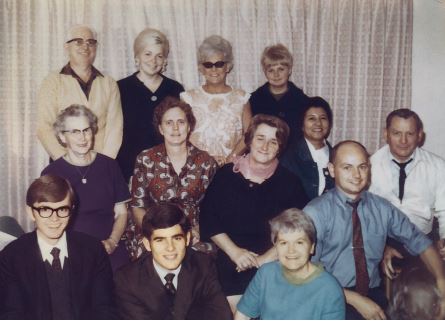 LDS gathering at 516 Clifton Street, Winnipeg, September 1969. Standing, left to right: Vic Kidd (husband of Agnes Kidd), Sandy Eilfson, Pearl Purdy Nancollas, and Alexis Novak. Seated in centre, left to right: Norma Durrant, visiting from Lewiston, Utah; Agnes Kidd, Irene Cormack, Irene Currens, and Harold Purdy. Front row, left to right: Elders Parker and Don C. Gilbreth, Margaret Purdy, and her nephew Carl Nancollas, who was also visiting from Utah. (Margaret Purdy)
LDS gathering at 516 Clifton Street, Winnipeg, September 1969. Standing, left to right: Vic Kidd (husband of Agnes Kidd), Sandy Eilfson, Pearl Purdy Nancollas, and Alexis Novak. Seated in centre, left to right: Norma Durrant, visiting from Lewiston, Utah; Agnes Kidd, Irene Cormack, Irene Currens, and Harold Purdy. Front row, left to right: Elders Parker and Don C. Gilbreth, Margaret Purdy, and her nephew Carl Nancollas, who was also visiting from Utah. (Margaret Purdy)
Portage la Prairie also benefitted from its nearby military base, and during the 1950s and 1960s, when it was at maximum capacity, LDS military personnel stationed there were a boon to the local branch.[133] However, as the base was downgraded and finally closed, that source of support ended, and for a time this little branch was closed.
Thompson became a boomtown in northern Manitoba after nickel was discovered there in the 1950s. Its first LDS meetings were held in 1961, the missionaries arrived in 1963, and an independent branch was created in 1969, followed by the construction of a meetinghouse in 1970.[134] The congregation grew rapidly in the early years of the mine, partly through the arrival of LDS members and partly through new converts, including Jack R. Knight, the first mayor of Thompson and first president of the Thompson Branch.[135] Regrettably, the branch’s fortunes have been closely tied with the mining industry, which has been on the wane for a number of years. Moreover, the pull to more populous centres of the Church has made it difficult to keep the branch going. Nevertheless, Jim and Cathy Hinds, who arrived in the community in 1969, have faithfully held on and maintained the LDS presence in that northern community.
In Winnipeg, the Winnipeg Third Branch, created in 1969, shared the Academy building with the First and Second Branches for a year before moving to École Van Belleghem in Saint Boniface. Such reorganization reflected the growth occurring elsewhere in the North Central States Mission and neighbouring missions that eventually led to adjustment in their boundaries and the creation of the Canada Winnipeg Mission in 1976. In that same year, the Winnipeg Third Branch moved into a newly built chapel at 700 London, in the northeast section of the city, and land was purchased in the southern part of the city for a future stake centre.[136] The following year, two new branches in Winnipeg were created, the Winnipeg Fourth Branch and the Winnipeg Spanish Branch, both of which met in the London Chapel.[137] This latter branch was the result of an influx of Chilean political refugees to the area and the active missionary work among this group by Spanish-speaking missionaries newly assigned to the mission.[138]
At the district level, there were several changes in leadership during those years. In August 1976, Wayne Nysetvold became district president, replacing Clive Northcott, who had suffered a stroke after only four years of service. Nysetvold remained less than a year because of a job transfer to Calgary, and he was replaced in May 1977 by James R. Walker, a professor at the University of Winnipeg. A year later, Walker accepted a job as a faculty member at BYU–Hawaii, and Lorne L. Clapson was sustained as the new district president in May 1978.[139]
Church membership in Manitoba grew from 1,281 in 1970 to 1,709 in 1977.[140] With this increase in district members, new meetinghouses being built, and new branches being organized, the goal of stakehood seemed within reach. Outside the city, change and reorganization were the order of the day. In August 1977, the Selkirk Branch was created just northeast of Winnipeg, with Arnold H. Anderson as its first president.[141] In November 1977, the Portage la Prairie Branch was closed when the last of its Melchizedek Priesthood families moved away, but in August 1978, three small congregations were organized at Woodlands, Ste. Anne, and Dauphin.[142] Rex D. Pinegar of the Seventy made repeated visits to Winnipeg during 1977 and 1978, encouraging local Church leaders to improve their performance in order to qualify for stakehood. Statistics on sacrament meeting attendance, home teaching, and overall activity were submitted regularly for review to Elder Pinegar in Salt Lake City. The Church Welfare Program was fully implemented, and more men were advanced to the Melchizedek Priesthood.[143] Momentum built as leaders and members worked together to attain their goal.
The climax of this effort and anticipation came on 12 November 1978, when L. Tom Perry of the Quorum of the Twelve attended a conference of the Winnipeg Manitoba District, held in the Playhouse Theatre in Winnipeg. A total of 963 people attended the conference, in which Elder Perry officially created the Winnipeg Manitoba Stake. Lorne L. Clapson was sustained as president, with counselors John F. Van Orman and Bruce Pinkney.[144] Mark L. Spencer was called as patriarch. The new stake consisted of five wards (Brandon and the Winnipeg First, Second, Third, and Fourth Wards) and six branches (Selkirk; Ste. Anne; Woodlands; Winnipeg Spanish; Kenora, Ontario; and Williams [Warroad], Minnesota).[145] Thompson was not included in the stake but remained under the Winnipeg Manitoba Mission until 1980, when the short-lived Thompson District was created. It included three small and widely separated branches at Thompson, Flin Flon, and The Pas, and although meetinghouses were dedicated in Thompson and Flin Flon in 1983, the district existed for only a short time. Flin Flon was transferred to the Saskatoon Saskatchewan Stake in 1984, The Pas closed the same year, and Thompson transferred to the Winnipeg Manitoba Stake in 1986.[146]
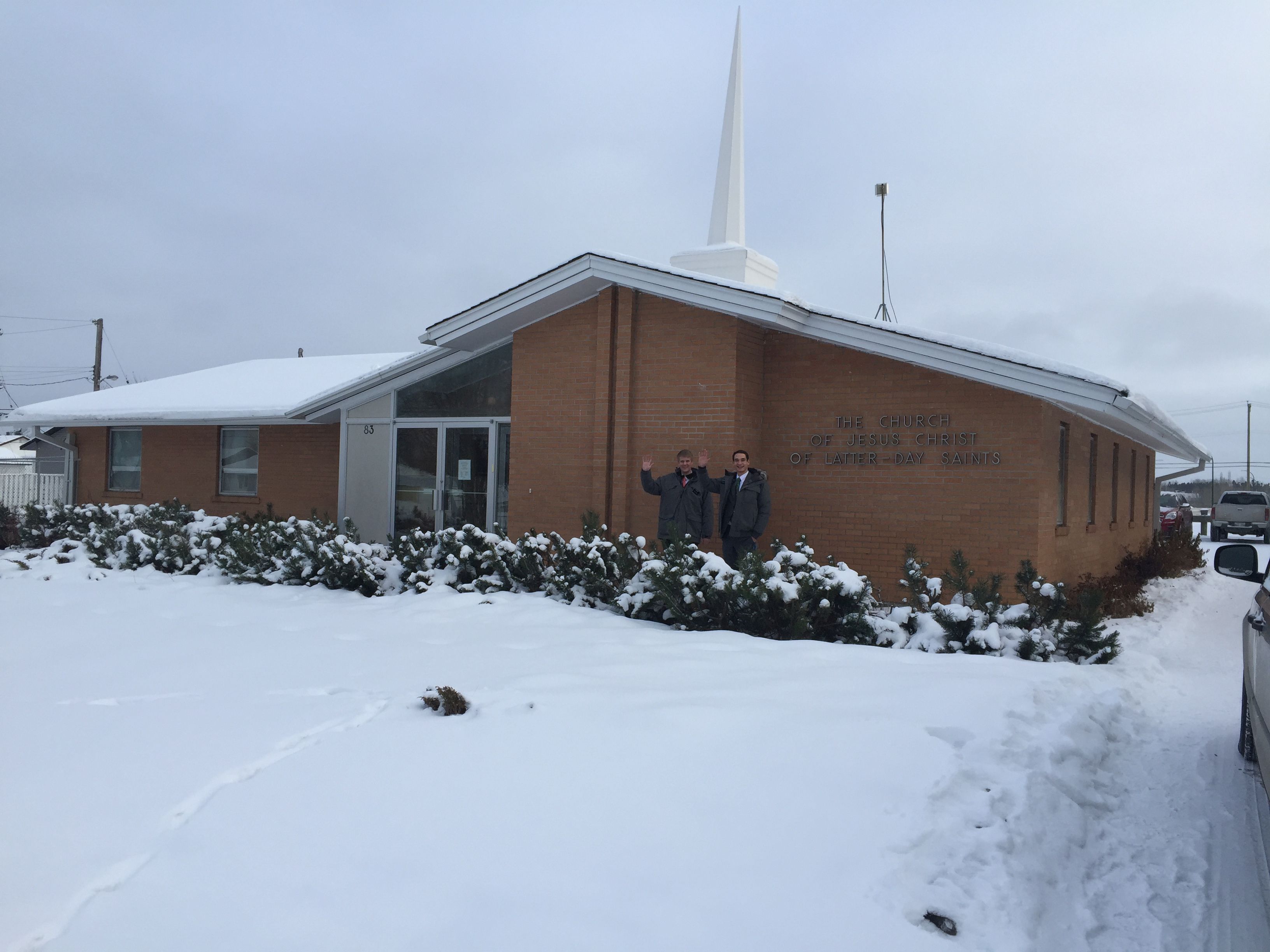 Thompson meetinghouse, 2016. Built for small congregations, first-phase buildings such as this may be enlarged by the construction of additional phases as congregations grow in number. (John N. Craig)
Thompson meetinghouse, 2016. Built for small congregations, first-phase buildings such as this may be enlarged by the construction of additional phases as congregations grow in number. (John N. Craig)
The 1980s saw a number of other developments. Church membership in Manitoba nearly doubled from 1,904 in 1980 to 3,660 in 1990.[147] A chapel was built and dedicated in 1980 for the Kenora Saints, who had been meeting in rented facilities since the formation of the branch in 1955.[148] This chapel was followed by the construction of the Selkirk meetinghouse, which was dedicated in June 1982 at a service described as “a very joyous and spiritual occasion for all those attending.”[149] A Filipino branch, the Winnipeg Fifth Branch, was created in 1983 to accommodate LDS members in that growing ethnic community. It thrived, and within a year, it had doubled its membership, growing from nineteen to thirty-eight families through the fellowship and the friendliness of branch members.[150] Although the branch was closed in 1989, its members have added their numbers and spiritual strength to every unit of the Church in Winnipeg.
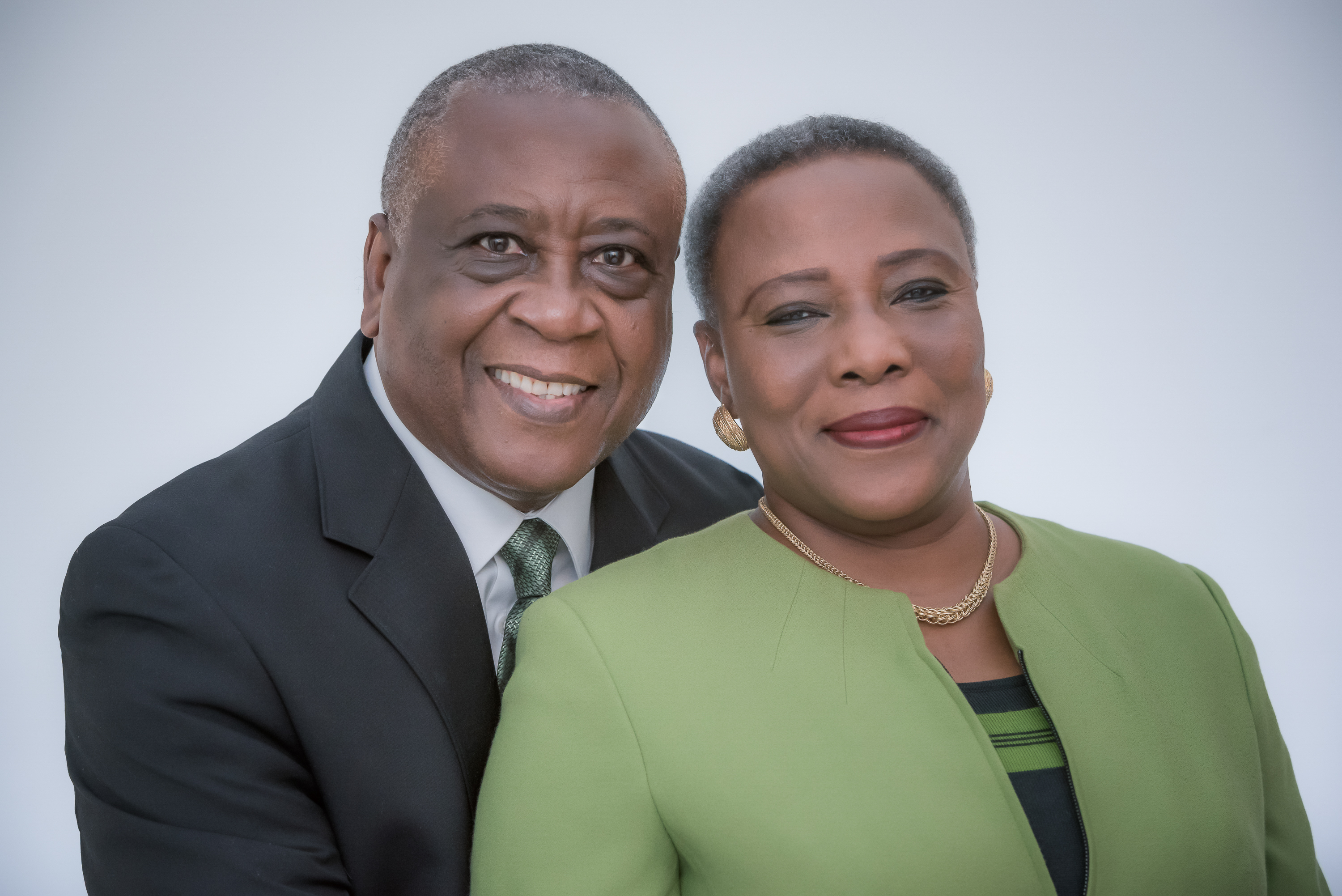 The increasingly cosmopolitan nature of the Church in Manitoba is one of its greatest strengths. Recently, members of the Dalhousie Ward in Winnipeg—Cornelius Olanrewaju Tay and his wife, Caroline Olabisi Tay—were called to return to their former homeland to preside over the Nigeria Lagos Mission. (Dates Nocum)
The increasingly cosmopolitan nature of the Church in Manitoba is one of its greatest strengths. Recently, members of the Dalhousie Ward in Winnipeg—Cornelius Olanrewaju Tay and his wife, Caroline Olabisi Tay—were called to return to their former homeland to preside over the Nigeria Lagos Mission. (Dates Nocum)
A Lamanite branch, presided over by a missionary couple, Elder Austin Whitmer and his wife, was organized in 1980 at Winnipeg in response to a growing Aboriginal population.[151] Among its members were Ida Johnston and Annie Lachose, who exemplified the quiet spirituality they had inherited from their Cree roots.[152] The late Nancy Pompana of Sioux Valley, whose powerful testimony always brought the Holy Spirit into a fast and testimony meeting at Brandon, did likewise for the Dakota.[153] The Lamanite Branch remained in operation until 1983, when its members were transferred to the Winnipeg Third and Fourth Wards.[154] In view of the fact that at least 20 percent of Manitoba’s population has Aboriginal roots, the Lamanite Branch is a reminder that a central purpose of the Book of Mormon is to convince the descendants of Lehi that “Jesus is the Christ,” a work that has only just begun in this province.
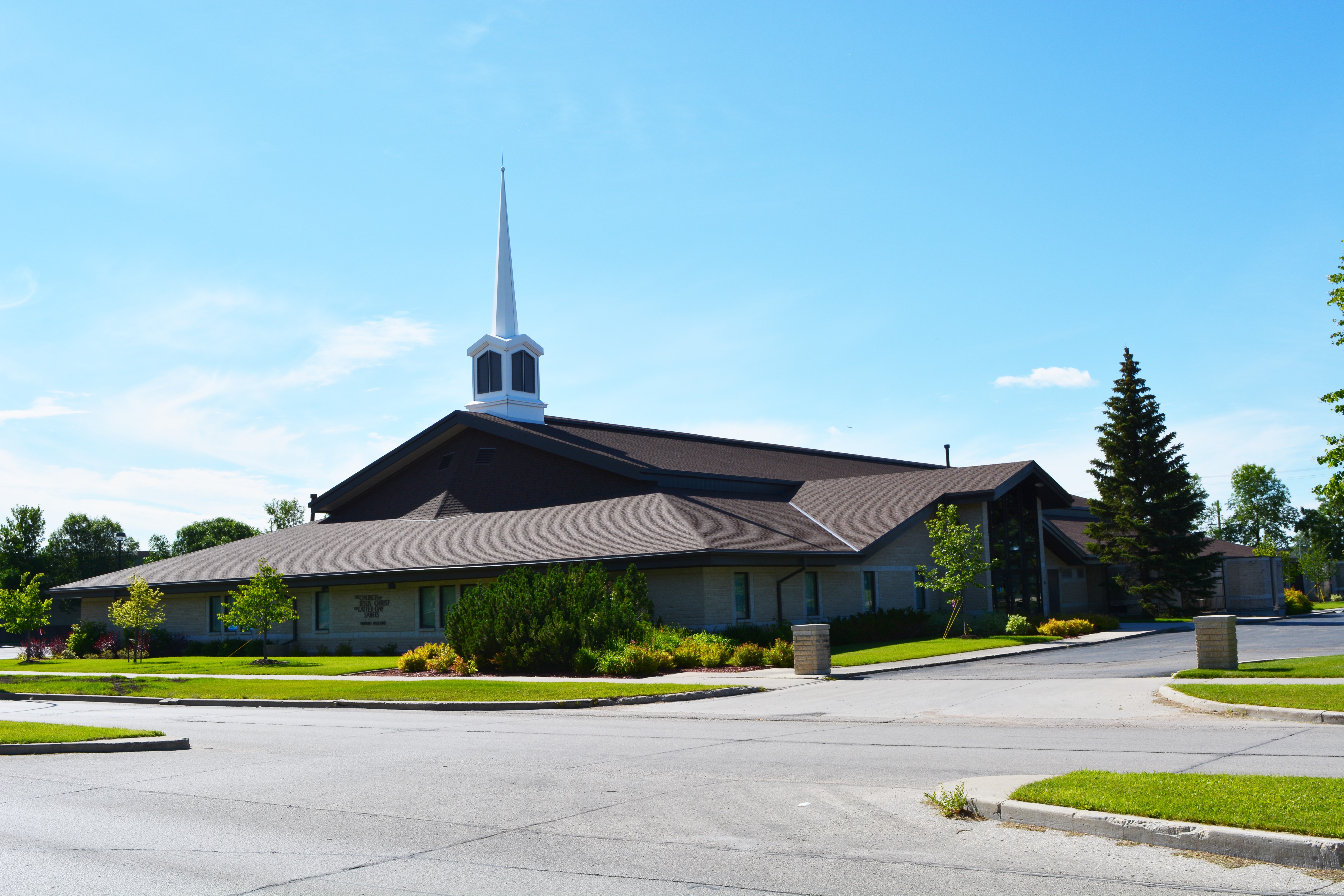 Winnipeg Manitoba Stake Centre, 45 Dalhousie Drive. In 2016, this building housed the stake offices, the family history centre, and the Dalhousie and Waverley Wards. (Kieran Shirritt-Beaumont)
Winnipeg Manitoba Stake Centre, 45 Dalhousie Drive. In 2016, this building housed the stake offices, the family history centre, and the Dalhousie and Waverley Wards. (Kieran Shirritt-Beaumont)
At the stake level, President Lorne L. Clapson was released as president in April 1987, after serving nine years. He was replaced by Richard E. Bennett, who presided over a groundbreaking ceremony in October 1987 that heralded the beginning of construction for the new stake centre at 45 Dalhousie.[155] Just over a year later, a weeklong series of celebrations—including guided tours, a musical concert, a comedy stage play, firesides, and a jubilee ball—marked the opening of the new building.[156] The addition of this new facility also prompted a relocation and renaming of the city wards, with Winnipeg First Ward becoming the Dalhousie Ward; Winnipeg Second, the St. James Ward; Winnipeg Third, the London Ward; and Winnipeg Fourth, the Academy Ward.[157] St. James and Academy Wards briefly met together in the Academy building until the latter moved to the new stake centre and was renamed the Waverley Ward. In 1995, the St. James Ward moved to its new chapel at Sturgeon and Ness in west Winnipeg, leaving the Academy chapel to the Young Single Adult branch, which was created in 1993 and became a ward in 2000.[158]
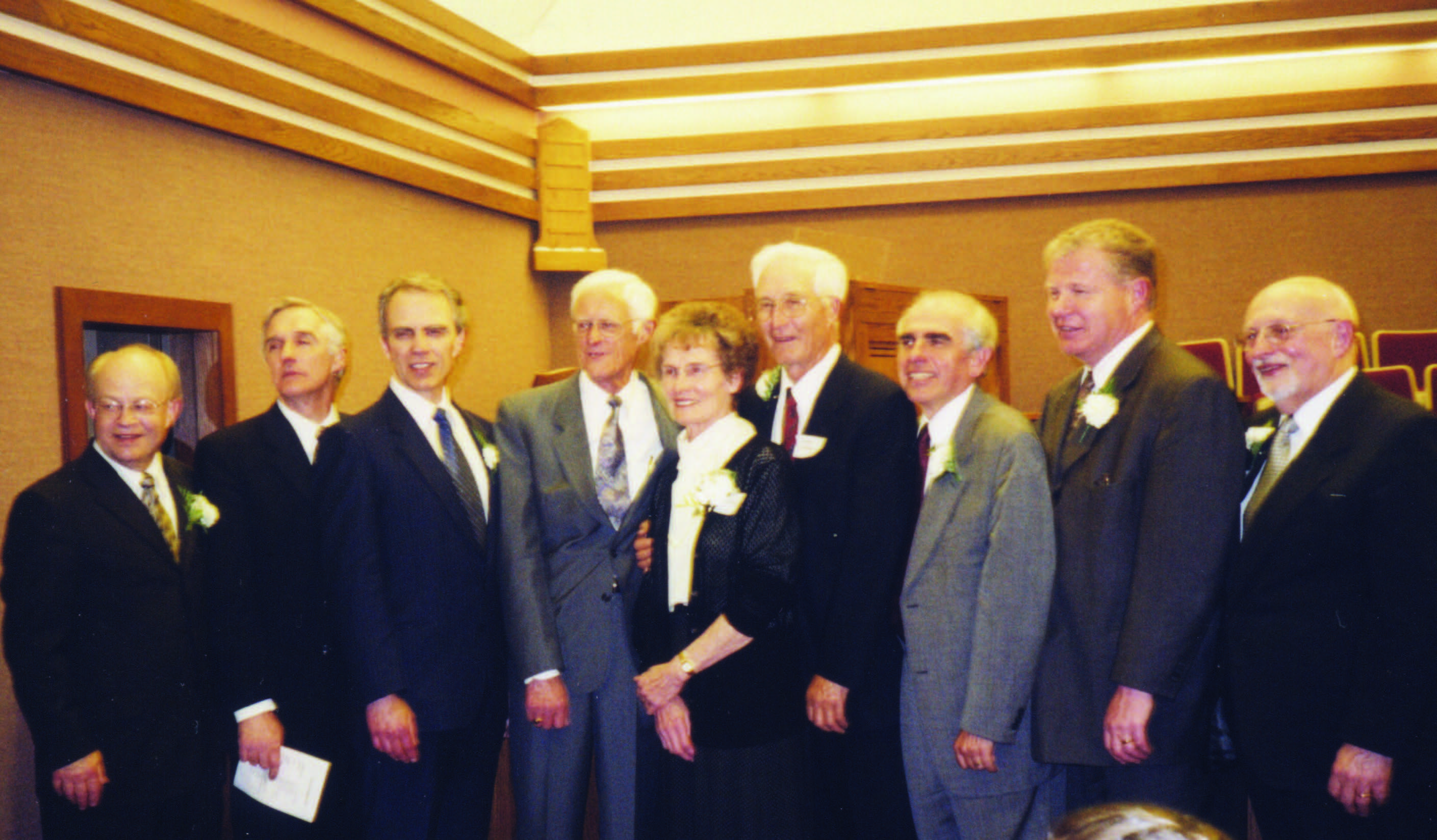 Current and former stake presidencies and other leaders at the twenty-fifth anniversary of the creation of the Winnipeg Manitoba Stake, 2003. Left to right: Randy Oler, Dennis Woodford, George Spencer, Gordon Mears, Lesley and Lorne Clapson, Richard Bennett, Arnold Anderson, and Bruce Pinkney. (Margaret Purdy)
Current and former stake presidencies and other leaders at the twenty-fifth anniversary of the creation of the Winnipeg Manitoba Stake, 2003. Left to right: Randy Oler, Dennis Woodford, George Spencer, Gordon Mears, Lesley and Lorne Clapson, Richard Bennett, Arnold Anderson, and Bruce Pinkney. (Margaret Purdy)
Other changes in the stake included the reestablishment of the Portage la Prairie Branch in 1987, a small unit that has remained active ever since. The Dauphin Branch was reestablished in 1992 and has grown in part because of an influx of Alberta ranchers to the area but also because of local conversions. Its meetinghouse was purchased in 2005 and dedicated in 2006.[159] A chapel was also built for the Warroad (formerly Williams) Branch and dedicated 30 July 2006.[160] Prior to the creation of dependent branches at Winker and Neepawa in 2014 and the re-creation of the Steinbach Branch in 2017, the most recent addition to the stake, was the Gateway Ward, which was created in 2000 through a division of the London Ward.[161]
The significant growth of Church membership in the 1980s slowed in the 1990s and into the new century, as it did elsewhere in Canada and the United States.[162] Nevertheless, it has not led to a corresponding slowdown in service by Manitoba Saints to their communities. A year after George L. Spencer became stake president in 1996, the Saints in Winnipeg worked side by side with their neighbours to avert widespread flooding in the city.[163] In April 1997, Winnipeg experienced the blizzard of the century, which resulted in the cancellation of all Church meetings, including general conference session broadcasts on April 6. This was followed by the flood of the century, which resulted in a state of emergency in Winnipeg and a citywide sandbagging operation, to which missionaries and members alike responded.[164] Floods occurred in 2009 and again in 2011, when much of Minot, North Dakota, was inundated by the rising Souris River. More than three hundred men from the stake travelled south to the flood scene to help clean up and repair damaged homes.[165]
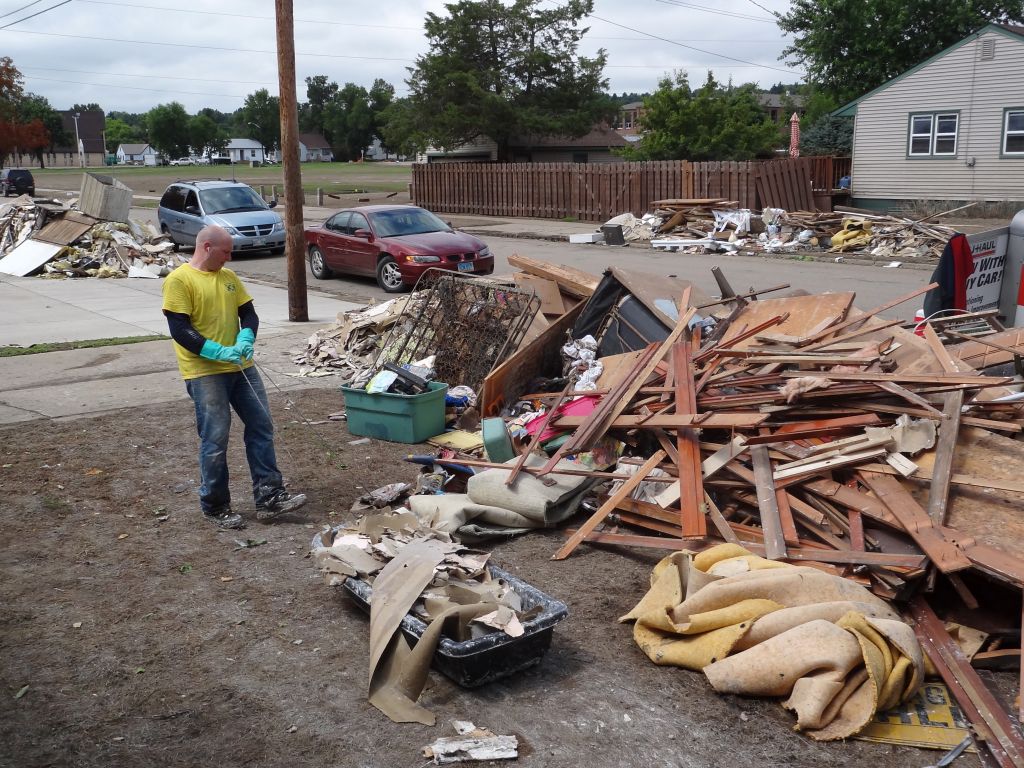 In 2011, three hundred men travelled more than 300 miles (about 480 kilometres) from Winnipeg to Minot, North Dakota, at their own expense to assist the victims of devastating flooding. The volunteers, wearing Mormon Helping Hands vests, slept in tents and provided their own food during their stay.[166] Joshua M. Guninger, shown here, was one of the volunteers. He became president of the Winnipeg Manitoba Stake in 2014. (Craig Owens)
In 2011, three hundred men travelled more than 300 miles (about 480 kilometres) from Winnipeg to Minot, North Dakota, at their own expense to assist the victims of devastating flooding. The volunteers, wearing Mormon Helping Hands vests, slept in tents and provided their own food during their stay.[166] Joshua M. Guninger, shown here, was one of the volunteers. He became president of the Winnipeg Manitoba Stake in 2014. (Craig Owens)
Community outreach has not been confined to emergency situations alone. From its inception in 2003, the live Nativity at the Forks has become an annual LDS contribution to Winnipeg’s celebration of Christmas. After 2005, when Allan Robison became stake president, such service received additional emphasis to help bring the Church out of obscurity. Perhaps the most significant result has been the annual Winnipeg Harvest food drive, which started out in 2005 as an LDS initiative and has expanded over the past ten years to include the community at large.[167] Another initiative enlists volunteers by ward to serve at Siloam Mission, which makes daily meals and shelter available for the homeless. “Prelude to Christmas,” a December tradition that began in 2006, has now become an interfaith program of music involving the Winnipeg Stake and the Roman Catholic congregation of Mary Mother of the Church. Family history centres throughout the stake continue to be open to the public at regular times weekly. During the past three years, the centre at 45 Dalhousie has also opened its doors to two major genealogical conferences.[168]
Culmination of a Dream
Perhaps the most significant development within the stake in recent years has been connected with temple worship, which was always hampered previously by the remoteness of the stake from its designated temple at Cardston. This isolation was reinforced in 1988, when that temple was closed for three years of painstaking renovations. When it opened again in 1991, many local Saints made the lengthy trip west for its rededication. However, with the opening of the Regina Saskatchewan Temple in November 1999, that long journey to Cardston was cut by more than half. The announcement of the new Regina temple had been made by President Gordon B. Hinckley in August 1998 while on a nine-day tour of Canada. During his visit to Winnipeg, President Hinckley promised that eventually Winnipeg would have its own temple. No one believed that this would occur any time soon, so there was shock and jubilation in April 2011, when Thomas S. Monson, President of the Church, announced that a temple would be built in Winnipeg. At that time, stake president Allan N. Robison told a reporter from the Winnipeg Free Press that “this is the most important thing that has ever happened to us.”[171] However, temple building can be a slow process. When President Robison was released in 2014 and Joshua Gruninger sustained as the new stake president, there still had been no official announcement regarding location and groundbreaking ceremonies. Finally, on 3 December 2016, after all necessary approvals relative to the location had been given, the long-awaited groundbreaking for the new temple was held at 2 Centre Street in Winnipeg. Officials estimated that construction of the temple would take about two years.[172] At last, a temple will rise in Manitoba, the place where “the Spirit is speaking” and its doors open to faithful Saints who have come here from every corner of the world—from Europe and Asia and more recently from Latin America and Africa—all of whom will have access to the blessings of the Lord’s house, where the Spirit truly dwells. The dream of a century will finally be fulfilled.
Notes
[1] The Dene and Inuit were located in the northern part of the watershed, the Cree in the northeast and central regions, the Blackfoot in the southwest, and the Nakota (Assiniboine) and Dakota to the south and southeast. The Ojibway, relatively late in arriving, entered the region from the Great Lakes with the French traders.
[2] H. Frank Hall, “How Manitoba Got Its Name,” Manitoba Pageant 15, no. 2 (Winter 1970), http://
[3] Deseret News, 1 May 1879, reproduced in Journal History of the Church, 7 April 1879, reel 38, Church History Library, Salt Lake City (hereafter CHL).
[4] “Looking Backward Thirty Years Ago,” Manitoba Free Press, Monday, 12 July 1909, 1. The tone of news reports was no better in 1874, when missionaries, evidently from the Reorganized Church, received a mocking welcome to Winnipeg as follows: “Three Mormon preachers are said to have been among the good things imported by Snyder & Anderson’s flat-boats. One of them inadvertently became a Baptist last evening through accidently stepping into the river.” Daily Free Press, 22 July 1874, 3. Reference kindly supplied by Gary Palmer, 15 December 2015.
[5] See Deseret News, 1 May 1879, reproduced in Journal History of the Church, 7 April 1879, reel 38, CHL. Also, Theodore Brandley Journals, 1869–1904, Journal, 1884 April–1885 October, entry for 30 June 1884, CHL, MS 5320; Hal Pruden, Mormons in Manitoba: A Short History of the Church of Jesus Christ of Latter-day Saints in Manitoba (Winnipeg: Winnipeg Manitoba Stake, 1988), 1.
[6] At the time, Cardston was in the NorthWest Territories. For more information on the origins of the Mormon settlement in Alberta, see Lethbridge Stake, A History of the Mormon Church in Canada (Lethbridge: Lethbridge Herald, 1968), 24–35.
[7] Pruden, Mormons in Manitoba, 6. See also the entry for 5 December1896 in Charles O. Card, The Diaries of Charles Ora Card: The Canadian Years, 1886–1903, ed. Donald G. Godfrey and Brigham Y. Card (Salt Lake City: University of Utah Press, 1993), 374.
[8] See Edward J. Leavitt Diaries 1896–1898, CHL, MS 9444; Manitoba Morning Free Press, 1 March 1897, 4, Winnipeg Free Press Archives at http://
[9] Leavitt Diaries, entry for 14 March 1897; Manitoba Free Press, 9 July 1897, 3, and 22 July 1899, 3; Alberta Stake Presidents Correspondence, Ramsbottom to Card, 8 September 1898, CHL, LR 10540 46.
[10] Leavitt Diaries, entry for 11 August 1897.
[11] See Leavitt Diaries, entry for 16 August 1897; Minnedosa Tribune, 12 August 1897, 3, at http://
[12] Leavitt Diaries, entries for 13–16 August 1897.
[13] Leavitt Diaries, entries for 22–23 December 1897.
[14] Winnipeg Branch General Minutes (hereafter WBGM), folder 9, Record of Baptisms, 2–3, CHL, LR 10241 11; Card Diaries, 408, 428–29.
[15] Runions’s letters to the Brandon paper were answered by President C. O. Card in December 1897, while he was visiting the mission, and by Elder Leavitt in January 1898. Leavitt Diaries, entries for 5 and 25 January 1898.
[16] Alberta Stake Presidents Correspondence, Baxter to Card, 10 December 1898.
[17] Alberta Stake Presidents Correspondence, Merkley to Card, 17 May 1899.
[18] Northern States Mission Manuscript History and Historical Reports (hereafter NSMMHHR), 26 December 1899, box 1, volume 2, folder 2, CHL, LR 6227 2. See “Manitoba Conference: The Gospel Spreading Under the Pressure of Opposition,” Deseret Evening News, 3 November 1900, in Journal History, 24 October 1900, 8, reel 99, CHL.
[19] Alva J. Moore, Journals and Correspondence, 1899–1901, entry for 6 November 1900.
[20] Her temple work has been completed.
[21] Alva J. Moore, Journals and Correspondence, 1899–1901, entry for 15 May 1901.
[22] For more information see Jaynann Morgan Payne, “Mary Smith Ellsworth: Example of Obedience,” The Ensign, April 1973, at https://
[23] Manitoba Free Press, 9 November 1906, 7; Illinois Chicago Mission Manuscript History and Historical Reports (hereafter ICMMHHR), 1, 9 November 1906, box 2, volume 3, folder 1, CHL, LR 6227 2.
[24] Manitoba Free Press, 23 April 1904, 17, 19; “Raymond Flourishing: Mormon Farmers Send Flour to Japanese–Sugar Beet Contracts,” Manitoba Free Press, 27 February 1904, 20; “Great Influx into Alberta: Rapid Growth of Raymond, Cardston, Sterling and Magrath,” 1 April 1904, 6; “Irrigation and Its Benefits,” 8 September 1904, 7.
[25] Manitoba Free Press, 18 November 1905, 22.
[26] Williams enrolled at the Brandon College of the University of Manitoba in 1898, while serving as a missionary in the Manitoba Conference, and completed his first and second year there. In October 1901, he resumed his studies at the Manitoba College in Winnipeg, where he completed his third and fourth years. Pruden, Mormons in Manitoba, 7–9, 11; University of Winnipeg Archives, Manitoba College Register, Faculty of Arts, Year 1901–1902, 10; and Faculty of Arts, Year 1902–1903, 17. See also, “Graduate of Manitoba College is President of Mormon Church,” Manitoba Free Press, 22 November 1913, 48.
[27] Pruden, Mormons in Manitoba, 8. During the 1905 election, Woolf was described as “one of the brightest men” in southern Alberta. “Exciting Fights for Alberta Seats,” Manitoba Free Press, 7 November 1905, 1, 7.
[28] George Siamandas, “Immigration Background to Winnipeg,” http://
[29] Carol Cornwall Madsen, “‘North Star’ Harvest,” Deseret News, 13 May 1978, 16.
[30] “The Latter Day Saints—The Rival Churches,” Manitoba Free Press, 12 September 1906, 11; “Letter from a Mormon Elder,” Manitoba Free Press, 15 September 1906, 17; “Reply to a Mormon Elder,” Manitoba Free Press, 5 October 1906, 5; “Letter from a Mormon Elder,” Manitoba Free Press, 11 October 1906, 5.
[31] Manitoba Free Press, 23 March 1906, 5. Manitoba Conference, Northern States Mission, Record of Members 1897–1914 (hereafter Manitoba Conference Record of Members), 2–3, Family History Library, Salt Lake City (hereafter FHL), mf. 0105331.
[32] See “Manitoba Conference,” Liahona, The Elders’ Journal, 9 May 1908, 1258–59, in ICMMHHR, 19 April 1908, box 2, volume 3, folder 2, CHL, LR 6227 2.
[33] Manitoba Free Press, Wednesday, 28 October 1908, 4.
[34] Manitoba Conference, Record of Members, 2–3, FHL, mf. 0105331. Brother Brewster became Sunday School superintendent on 23 May 1909. See Pruden, Mormons in Manitoba, 12n93.
[35] The baptisms occurred 15 May at the German Baptist Church, whose minister had kindly granted permission for the use of its baptismal font. See “Manitoba,” Liahona, The Elders’ Journal, 18 June 1910, 838, in ICMMHHR, 29 May 1910, box 2, volume 3, folder 2, CHL, LR 6227 2.
[36] “Manitoba,” Liahona, The Elders’ Journal, 17 January 1911, 494, in ICMMHHR, 17 January 1911, box 2, volume 3, folder 3, CHL, LR 6227 2.
[37] “Manitoba,” Liahona, The Elders’ Journal, 29 August 1911 and 21 November 1911, in ICMMHHR, box 2, volume 3, folder 3, CHL, LR 6227 2. They had already moved from 215 Nena to the hall at 220 Nena in 1910 and would move again to 932 Sherbrooke in 1912.
[38] Manitoba Free Press, Winnipeg, 13 June 1911, 1, and Thursday, 15 June 1911, 5.
[39] Information on the conversion of Minnie Purdy was provided by daughter Margaret Purdy and grandchildren Carl Nancollas and Lee Noel.
[40] Manitoba Conference, Record of Members, 63, FHL, mf. 0105331.
[41] “Manitoba,” Liahona, The Elders’ Journal, 12 March 1912, in ICMMHHR, box 2, volume 3, folder 3, CHL, LR 6227 2.
[42] “Manitoba,” Liahona, The Elders’ Journal, 16 January 1912 and 15 September 1912, in ICMMHHR, box 2, volume 3, folder 3, CHL, LR 6227 2.
[43] Manitoba Conference, Record of Members, 66, FHL, mf. 0105331.
[44] Manitoba Conference, Record of Members, 70–71, FHL, mf. 0105331. This source also mentions in several pages the various sites where baptisms took place.
[45] The lot was thirty-three-feet wide and cost the mission $1,442.90, which was paid in full on 16 June 1913. Manitoba Conference, Record of Members, 70–71, FHL, mf. 0105331.
[46] See “Chief Sitting Eagle Dies at Old Home in Turtle Mountain,” Deloraine Times and Waskada News, Deloraine, Manitoba, 4 May 1944, 1.
[47] Manitoba District, Record of Members, 1925–1946, book 28059, in index under “Eagle, Sitting,” item 59; Glenn N. Rowe (Historical Department, Salt Lake City), correspondence with Margaret Purdy [Zaruk], 1 May 1984.
[48] As the Dakota were under the jurisdiction of the Indian Act, the missionaries had to seek the consent of the local Indian agent to officially enter the reserve, and this request appears not to have been granted. For more information, see “Manitoba,” Liahona, The Elders’ Journal, 25 August 1914, in ICMMHHR, 25 August 1914, box 2, volume 4, folder 1, CHL, LR 6227 2.
[49] Margaret Purdy Reminiscences, in possession of Raymond Shirritt-Beaumont.
[50] Manitoba Free Press, 7 February 1913, 20; 2 August 1913, 10; 6 November 1913, 1; and 17 November 1913, 4.
[51] Manitoba Conference, Record of Members, 76–78, FHL, mf. 0105331.
[52] Orson F. Whitney, “Bishop O. F. Whitney Writes of St. Paul and Winnipeg Visits,” Deseret Evening News, 7 September 1914. See also ICMMHHR, 3 August 1914, box 2, volume 4, folder 1, CHL, LR 6227 2; Pruden, Mormons in Manitoba, 12. In 2017, the building still existed and was being used by another religious organization.
[53] For more on the pull to Zion and its impact on the growth of the Church in eastern Canada in earlier times, see Richard E. Bennett, “‘Plucking Not Planting’: Mormonism in Eastern Canada, 1830–1850,” in The Mormon Presence in Canada, ed. Brigham Y. Card and others (Edmonton: University of Alberta Press, 1990), 19–34.
[54] Branch President Denner left for Salt Lake City in 1913. He was replaced in November 1913 by Elder Enoch Jorgenson, with John Simpkin and W. W. Cliffe as counselors. A local member would not serve again as branch president until 1922. Manitoba Conference, Record of Members, 73, FHL, mf. 0105331.
[55] Research on the Jaffa family began in 2014, with information provided by Beth Nugent MacDonald of Minnedosa, Manitoba, who remembered that a sister of her maternal grandmother had “married a Mormon.” Her grandmother’s birth certificate was the key to finding and reuniting relatives who had been out of contact with each other for over ninety years.
[56] “Manitoba,” Liahona, The Elders’ Journal, 27–31 October 1914, 23 March 1915, and 28 May 1915, in ICMMHHR, box 2, volume 4, folder 1, CHL, LR 6227 2.
[57] “Manitoba,” Liahona, The Elders’ Journal, 11 January 1916, in ICMMHHR, box 2, volume 4, folder 1, CHL, LR 6227 2. The LDS men who had gone overseas by January 1916 included Cornelius and John de Winter, Maj. James Grindey, and William Banks.
[58] “Manitoba,” Liahona, The Elders’ Journal, 29 August 1916, in ICMMHHR, box 2, volume 4, folder 1, CHL, LR 6227 2.
[59] “Manitoba,” Liahona, The Elders’ Journal, 27 July and 24 August 1915, in ICMMHHR, box 2, volume 4, folder 1, CHL, LR 6227 2.
[60] “Manitoba,” Liahona, The Elders’ Journal, 27 March 1917, in ICMMHHR, box 3, volume 4, folder 2, CHL, LR 6227 2.
[61] ICMMHHR, 13 December 1918, box 3, volume 4, folder 2, CHL, LR 6227 2.
[62] ICMMHHR, 31 December 1918, box 3, volume 4, folder 2, CHL, LR 6227 2.
[63] Posttraumatic stress disorder, which was largely unrecognized at the time, probably led to the collapse of John de Winter’s first marriage and affected other returning soldiers in significant ways as well.
[64] Canada Toronto West Mission Manuscript History and Historical Reports (hereafter CTWMMHHR), 17 October 1920 and 25 September 1922, box 1, volume 1, part 1–2, folder 2, CHL, LR 6520 2. The Allreds arrived in October 1919 and were released on 25 September 1922.
[65] Manitoba District General Minutes (hereafter MDGM), March 1920, 6–7, folder 1, CHL, LR 5239 11.
[66] The name “conference” was replaced by “district” in 1928.
[67] According to Margaret Purdy, the raise equalled the tithing that had been paid. It is unclear whether Brother Gerber, a master chef, was working at the St. Regis Hotel or at Eaton’s at this time. A variation of the story indicates that he had to work on Sundays at the St. Regis, but after joining the Church, he got a job at Eaton’s and never had to work Sundays again.
[68] Story related by Margaret Purdy. Sister Arlt, who was born in Samara, Russia, remained active in the Church for the remainder of her life.
[69] Joseph Quinney Jr., “Testimony,” unpublished transcript in possession of Caroline Jensson Gate, Kenora, Ontario. Although President Quinney clearly stated it was Swedish relatives that made inquiries, another source suggests that John and Christian Olson themselves wrote letters requesting contact with the Church. See Cindy Gate, “The Mormon Pioneers of Northwestern Ontario” (unpublished manuscript, 1983), in possession of Caroline Jensson Gate, Kenora, Ontario.
[70] MDGM, 31 August 1925, folder 1, 9, CHL, LR 5239 11.
[71] MDGM, 18 July 1930, folder 1, 44, CHL, LR 5239 11.
[72] During October 1929, Elders W. Radford Wagstaff and Kelleth D. Bushnell visited the Pooles and their neighbours, who lived a few kilometres west of Neepawa. MDGM, 7 October 1929, folder 1, 41, CHL, LR 5239 11.
[73] Diary of W. Radford Wagstaff via email from son David Wagstaff to R. Shirritt-Beaumont, 29 June 2016. See versions of this incident in Julie A. Dockstader, “Missionary Moments: A Lot of Rejoicing,” Church News, 4 May 1991, 16; and James E. Faust, “Of Seeds and Soils,” Ensign, November 1999, https://
[74] “Manitoba,” Liahona, The Elders’ Journal, 19 May 1925, in CTWMMHHR, box 1, volume 2, part 1, folder 3, CHL, LR 5239 11.
[75] Margaret Purdy and her friends Gladys Lang and Inez Green always begged him to include “Hushed Was the Evening Hymn” somewhere in the program because they wanted to hear him announce “Oooshed Was the hevening ’ym.”
[76] Pruden, Mormons in Manitoba, 16; MDGM, 23 June 1929, folder 1, 36, CHL, LR 5239 11.
[77] MDGM, 16 August, 7 September, and 17 December 1930, folder 1, 45–46, 49, CHL, LR 5239 11.
[78] MDGM, 12–13 September 1931, folder 1, 56–57, CHL, LR 5239 11.
[79] MDGM, 10, 15 December and 2 April 1933, folder 1, 76 and 81, CHL, LR 5239 11.
[80] According to Margaret Purdy, after Martha joined the Church, Martha’s son-in-law had her committed by force to the Winnipeg General Hospital as insane. It did not take Martha long to convince the doctors that she was in full possession of her faculties, and she was released immediately.
[81] Margaret Purdy Reminiscences.
[82] Margaret Purdy watched as that sister missionary deftly persuaded the freight man at Union Station to send the boxes gratis.
[83] The Apostles who visited included George Albert Smith in 1931, 1935, and 1938; Joseph F. Merrill in 1932; Joseph Fielding Smith in 1933; Melvin J. Ballard in 1934 and 1937; Charles A. Callis in 1936; and Sylvester Q. Cannon in 1939.
[84] MDGM, 28 June 1934, folder 1, 89, CHL, LR 5239 11.
[85] Winnipeg Free Press, 16 July 1937, 5. The Church introduced the welfare program in 1936 to assist Church members in economic distress. Pruden, Mormons in Manitoba, 17.
[86] MDGM, 2 April 1937, folder 1, 103, CHL, LR 5239 11.
[87] By chance, they met an old friend whom they had known while growing up in Portage la Prairie. He was recruiting men for a job on the railroad and told them if they wanted work, they had to start that day. They accepted the offer without a moment’s hesitation.
[88] The Jacks were baptized 10 July by Raymond H. Goodwin, the recently released president of the Manitoba District, who had travelled from Rainy River to Winnipeg for a four-day visit prior to the official date of his release on July 11. There were no other missionaries in Winnipeg at that time. MDGM, 9–10 July 1938, folder 1, 117–18, CHL, LR 5239 11.
[89] Raymond Shirritt-Beaumont, “Bob Jack’s Remarkable Story,” (unpublished paper, January 2003). Although the author first heard about the vision from Bob Jack himself in 1963, the story was not written until 2003, after confirmation by Bob’s children, Roberta Cameron of Calgary and Tom Jack of Cardston.
[90] MDGM, 5 December 1938, folder 1, 128, CHL, LR 5239 11.
[91] MDGM, 27–28 August 1939, folder 1, 135, CHL, LR 5239 11.
[92] MDGM, 24 September and 12, 21 October 1939, folder 1, 135–136, CHL, LR 5239 11.
[93] MDGM, 6, 12 January, 14 July, 19 September, 28 October 1941, folder 1, 155, 159–161, CHL, LR 5239 11.
[94] Information provided by Gertrude Shine Gross, Brandon, Manitoba, February 2015.
[95] MDGM, 22 January 1940, folder 1, 141, CHL, LR 5239 11. The term “ward teaching,” which was renamed “home teaching” in 1963, refers to visits by assigned priesthood holders to the homes of Church members at least once a month. The Relief Society also assigned its members to visit each sister monthly.
[96] MDGM, 26 February 1940, folder 1, 142, CHL, LR 5239 11.
[97] MDGM, 17 March 1940, folder 1, 143–44, CHL, LR 5239 11.
[98] North Central States Mission (hereafter NCSM), 22, 29 April, 1 May, and 30 June 1944, Minnesota Minneapolis Mission Manuscript History and Historical Reports (hereafter MMMHHR), box 2, volume 3, part 2, folder 2, CHL, LR 6151 2.
[99] Fast Sunday, the first meeting of the month in the LDS Church, is an opportunity for the Saints to stand and bear their testimonies of Jesus Christ as well as to share inspirational experiences that have strengthened their faith.
[100] MDGM, 6 June 1942, folder 1, 167; 11–12 September 1943, folder 1, 187–88, CHL, LR 5239 11; NCSM, 3 June 1945, MMMMHHR, box 2, volume 3, part 2, folder 2, CHL, LR 6151 2.
[101] NCSM, 5 October 1946, MMMMHHR, box 2, volume 3, part 2, folder 2, CHL, LR 6151 2.
[102] NCSM, 20 March 1949, MMMMHHR, box 2, volume 4, part 2, folder 3, CHL, LR 6151 2. See also Pruden, Mormons in Manitoba, 19.
[103] NCSM, 10 May 1950, MMMMHHR, box 2, volume 4, part 2, folder 3, CHL, LR 6151 2. See also Pruden, Mormons in Manitoba, 19.
[104] The labour missionary program was instituted in the 1950s under the direction of Wendell Bird Mendenhall, head of the Church Building Department. The program involved labour missionaries who worked under the supervision of skilled tradesmen in building assignments as directed by the Church.
[105] Joan Richardson de Winter, interview by Raymond Shirritt-Beaumont, March 2015.
[106] WBGM, folder 18, December 1952, 40, CHL, LR 10241 11.
[107] NCSM, 15 September 1952, MMMMHHR, box 2, volume 5, part 1, folder 4, CHL, LR 6151 2. See also Pruden, Mormons in Manitoba, 19.
[108] NCSM, 28 February 1954 and 3 July 1955, MMMMHHR, box 2, volume 5, part 2, folder 5, CHL, LR 6151 2; MDGM, folder 2, 27 or 28 February 1954 and 5 July 1955, CHL, LR 5239 11.
[109] NCSM, 24 October 1954, MMMMHHR, box 2, volume 5, part 2, CHL, LR 6151 2; MDGM, folder 2, 24 October 1954, CHL, LR 5239 11.
[110] Pruden, Mormons in Manitoba, 18.
[111] WBGM, folder 18, December 1952, 40, CHL, LR 10241 11.
[112] WBGM, folder 6, 14 September 1952, 26 October 1952, 29 March 1953, 19 April 1953, CHL, LR 10241 11.
[113] WBGM, folder 18, 9 May 1954, 197–98, CHL, LR 10241 11. In his remarks, Elder Oscar Kirkham also stated that he could see the day when Winnipeg would have its own temple. Pruden, Mormons in Manitoba, 20.
[114] Portage la Prairie Branch manuscript history and historical reports, 30 September 1955, CHL, LR 7112 2, taken from the quarterly report of the North Central States Mission, 30 September 1955, 61.
[115] WBGM, folder 18, 22 March 1953, 21 June 1953, CHL, LR 10241 11.
[116] WBGM, folder 18, 21, 28 November 1954, CHL, LR 10241 11. President Gorner’s counselors were Alan C. Halsted and Stewart W. Nordine, who was a relatively new convert.
[117] Olive Wood, interview by Raymond Shirritt-Beaumont, March 2015.
[118] Pruden, Mormons in Manitoba, 20.
[119] WBGM, folder 2, 13 June 1958, 52–54, CHL, LR 10241 11.
[120] Pruden, Mormons in Manitoba, 20.
[121] Quarterly Historical Report (hereafter QHR), December 1964, Manitoba District Manuscript History and Historical Reports (hereafter MDMHHR), CHL, LR 5239 2.
[122] QHR, 31 December 1963, Winnipeg 2nd Branch Manuscript History and Historical Reports (hereafter W2BMHHR), CHL, LR 10239 2.
[123] Melvin S. Tagg, “A History of the Church of Jesus Christ of Latter-day Saints in Canada, 1830–1963” (PhD diss., Brigham Young University, 1963), 245.
[124] Hans Finken Sr., interview by Raymond Shirritt-Beaumont. See also Hans H. Finken, “The Story of My Life: Hans Heinrich Finken” (undated manuscript), in possession of Hans Finken Jr.
[125] For a tribute to the Finken family, see James Walker, “Starting Over,” Brigham Young University–Hawaii devotional, 27 May 2004, https://
[126] Sustaining Sheet for Conference of the Manitoba District, 17 February 1963, MDMHHR, CHL, LR 5239 2.
[127] The ratio of Church to local financial participation in building projects changed over the years from 70:30 in 1960, to 96:4 in 1982, and to 100:0 in 1990. See http://
[128] MDMHHR, 14 February and 5, 25 March 1963, CHL, LR 5239 2. See Dorothy E. Northcott, “Rededication,” 2 November 1986, CHL, MS 9409.
[129] Information provided by Sister Nadine Barfuss, whose husband, Milo Barfuss, was Sister Goett’s bishop in those years.
[130] For example, one of Elder Bennett’s sisters received a message on her death bed from the spirit world that identified the location of an important family record that had eluded them for many years. See an entry on his life at https://
[131] Sister Satterfield cited a Guideposts magazine article entitled “A Soldier’s Account of a Near-Death Experience,” by George C. Ritchie Jr., MD. Near-death experiences were rarely discussed or reported in the 1960s, so Sister Satterfield’s talk introduced members to a new type of evidence in support of life after death.
[132] President Brown, who was nearly eighty-seven years of age, spoke in Saint Mary’s Academy auditorium on 24 August 1970. WBMHHR, folder 1, historical report of 31 August 1970, 24 August 1970, CHL, LR 10241 2, researched by Carma J. Prete, 12 November 2015.
[133] See “Canadian Forces Base Portage la Prairie” at https://
[134] Graham Buckingham, Thompson: A City and Its People (Thompson, MB: Thompson Historical Society, 1988), 119. See http://
[135] Information provided by Maggie Hadfield and Jim and Cathy Hinds, November/
[136] Historical Events, 1976, MDMHHR, CHL, LR 5239 2; Historical Events, 31 December 1976, CWMMHHR, CHL, LR 15934 2. The Third Branch meetinghouse was dedicated 30 May 1976 by N. Eldon Tanner of the First Presidency.
[137] Waverley Ward Historical Information, Church Directory of Organizations and Leaders (hereafter CDOL), last updated 9 March 2014, cdol.lds.org; Historical Events, 31 December 1977, MDMHHR, CHL, LR 5239 2. Winnipeg Spanish Branch Historical Information, CDOL, last updated 13 September 2007, cdol.lds.org.
[138] Historical Events, 31 December 1977, MDMHHR, CHL, LR 5239 2. Information provided by Lucia Carrasco, 4 December 2015.
[139] Historical Events, 31 December 1976, MDMHHR, CHL, LR 5230 2; Historical Events, 1977, and Changes of Officers and Teachers, 1977, MDMHHR, March–June 1977, CHL, LR 5239 2; Historical Record, Section B—Historical Events, 1978, 2, Winnipeg Manitoba Stake Annual Historical Reports (hereafter WMSAHR), CHL, LR 18914 3.
[140] Dean Perkins (of the Member and Statistical Records Division, The Church of Jesus Christ of Latter-day Saints), email message to Barbara Hafen (profile manager), Church History Department, 8 July 2014.
[141] Historical Events, 31 December 1977, MDMHHR, CHL, LR 5249 3.
[142] These small branches were not officially listed as separate units at that time, but the plan was that they would be when the Winnipeg Stake was created. Historical Events, 31 December 1977, MDMHHR, CHL, LR 5239 2; Historical Record, Section B—Historical Events, 1978, 3, WMSAHR, CHL, LR 18914 3.
[143] Historical Events, 31 December 1977, MDMHHR, CHD, LR 5239 2; Historical Records, Section B—Historical Events, 1978, 1–3, WMSAHR, CHL, LR 18914 3.
[144] Historical Records, Section B—Historical Events, 1978, 3, WMSAHR, CHL, LR 18914 3. Carma Prete, Manitoba, Canada: LDS Historical Country Profile, 23 October 2014, Chapter 6, Biographies, CHL.
[145] Selkirk thrived, but Ste. Anne was closed in 1981, and its members transferred to the Winnipeg Fourth Ward. Woodlands also closed at about the same time. Dauphin became an independent branch in 1979, closed in 1986, and reopened in 1992. Kenora, located in northwestern Ontario and previously assigned to the Fort Frances District in 1976, was a part of the Winnipeg Manitoba Stake until 2016, when it returned to the Fort Frances Ontario District. Williams (Warroad), originally organized in 1962 as the Baudette Branch and located just across the border in northern Minnesota, was likewise assigned to the Fort Frances Ontario District in 2016. Sources for the above are the Brandon, Dalhousie, London, Waverley Wards and the Dauphin and Warroad (Williams) Branches, Historical Information, CDOL, last updated 9 March 2014, cdol.lds.org; St. James Ward Historical Information, CDOL, last updated 15 July 2013, cdol.lds.org; Historical Record, Section B—Historical Events, 1978, 3–4, WMSAHR, CHL, LR 18914 3; and Historical Record, Section B—Historical Events, Relief Society, 1978, WMSAHR, folder 1, CHL, LR 18914 3. For the Selkirk reference, see Selkirk Branch Annual Historical Reports, 1982, CHL, LR 17084 3. For the reference to the transfer of the Kenora Branch in 1976 to the Fort Frances District, see Historical Events, 31 December 1976, Canada Winnipeg Mission Manuscript History and Historical Reports (hereafter CWMMHHR), CHL, LR 15934 2. For Ste. Anne’s closure, see Ste. Anne Branch Historical Information, CDOL, last updated 13 September 2007, cdol.lds.org.
[146] Historical Record, Section B—Historical Events, 1980, Flin Flon Branch Manuscript History and Historical Reports, 19–20 July 1980, CHL, LR 15560 2; Thompson Branch Manuscript History and Historical Reports, 1981, CHL, LR 16528 2; Canada Winnipeg Mission Annual Historical Reports (hereafter CWMAHR), folder 2, 1983, 21–22 May 1983, CHL, LR 15934 3; Flin Flon Branch Associated Organizations and Historical Information, CDOL, last updated 4 February 2014, cdol.lds.org; The Pas Branch Historical Information, CDOL, last updated 13 September 2007, cdol.lds.org; and Thompson District Annual Historical Reports, 1986, CHL, LR 364 3.
[147] Dean Perkins (of the Member and Statistical Records Division, The Church of Jesus Christ of Latter-day Saints), email message to Barbara Hafen, profile manager, Church History Department, 8 July 2014.
[148] Information provided by Caroline Gate, Kenora, Ontario, 8 December 2015.
[149] Selkirk Branch Annual Historical Reports, 1982, CHL, LR 17084 3.
[150] CWMAHR, folder 2, 1983, 1, 2, 19, 31 January, 13–15 February, 5, 19 March, 29–30 April 1983, CHL, LR 15934 3.
[151] The term Lamanite refers to one of the peoples named in the Book of Mormon and is often used now to describe their descendants among the aboriginal people of America.
[152] Ida Johnston is a member of the Paupanekis family of Norway House, which was the mission headquarters of the Methodist Church in the Northwest during the 1840s. Her great-grandfather Edward Paupanekis was an ordained minister of that faith. Annie Lachose is originally from Easterville, a Cree community on Cedar Lake in northern Manitoba.
[153] Like her ancestors, Nancy received revelation via dreams and visions. Both her children served missions, and her son Lee and his family continue to be members of the Brandon Ward.
[154] Information provided by Annie Lachose, 7 December 2015. Winnipeg Lamanite Branch Historical Information, CDOL, last updated 13 September 2007, cdol.lds.org; CWMAHR, folder 1, 4 May 1980, CHL, LR 15934 3. This source gives the date of the branch’s organization as 4 May 1980.
[155] The stake offices had been located at 700 London since the creation of the stake in 1978. Winnipeg Manitoba Stake Historical Information, CDOL, last updated 14 July 2013, cdol.lds.org; CWMAHR, folder 2, 1983, 3 October 1983, CHL, LR 15934 3; Carma Prete, Manitoba, Canada: LDS Historical Country Profile, 23 October 2014, Chapter 6, Biographies, Bennett, Richard Edmond.
[156] Winnipeg Free Press, 18 November 1988, 5. The year 1988 was also a jubilee year marking the tenth anniversary of the creation of the Winnipeg Manitoba Stake.
[157] Dalhousie Ward, St. James Ward, and Waverley Ward Historical Information, CDOL, last updated 9 March 2014, cdol.lds.org; London Ward Historical Information, CDOL, last updated 15 July 2013, cdol.lds.org.
[158] There had been pressure to sell the Academy Road meetinghouse after the new stake centre was completed, but Dennis Woodford, a counselor to Richard E. Bennett, the stake president, argued that it was a central location for a young single adult branch. He felt a YSA branch might encourage the upcoming generation to remain and build the Church in Manitoba rather than moving elsewhere.
[159] The chapel is located at 403 Whitmore Avenue West. It was purchased from Western Christian College in 1995 and dedicated 15 January 2006 by President Allan Robison. Information provided by Virginia Fox, Beth Monson, and Allan Robison, 8/
[160] Christopher Steinbusch (stake clerk), November 2015, and Allan Robison (former stake president), 8 December 2015, email message.
[161] Steinbach Branch Historical Information, CDOL, last updated13 September 2007, cdol.lds.org. Gateway Ward Historical Information, CDOL, last updated 9 March 2014, cdol.lds.org.
[162] Dean Perkins (of the Member and Statistical Records Division, The Church of Jesus Christ of Latter-day Saints), email message to Barbara Hafen, profiles manager, Church History Department, 8 July 2014; Chapters “Growth, Distribution, and Ethnicity” and “Global Perspective,” herein.
[163] In April 1996, George L. Spencer replaced Richard E. Bennett as stake president, with Steven C. Diaczun and John R. Moore as counselors. Winnipeg Manitoba Stake Historical Information, CDOL, last updated 14 July 2013, cdol.lds.org.
[164] “Flood of the Century,” Chronology of Flood Events, 1997, History of Winnipeg, last updated 26 September 2014, http://
[165] See “Mormon Volunteers from Winnipeg Sacrifice to Repair Flood-Damaged Homes,” 29 July 2011, http://
[166] “Mormon Volunteers from Winnipeg Sacrifice to Repair Flood-Damaged Homes,” 29 July 2011, http://
[167] Information provided by Wayne Drozdowski, 12 December 2015. See also, “Mormons Help Set New Record at Winnipeg Harvest Food Drive,” LDS Newsroom, 3 August 2013, http://
[168] Information provided by Sheila Mears, director, Stake Family History Centre, 11 December 2015; WMSAHR, 2013, 1 June 2013, CHL, LR 18914 3.
[169] Information provided by Wayne Drozdowski, 12 December 2015. See also, “Mormons Help Set New Record at Winnipeg Harvest Food Drive,” LDS Newsroom, 3 August 2013, http://
[170] Information provided by Jessica Smith and John Moore, 14 December 2015, and Patrick Mathews, 17 December 2015.
[171] John Longhurst, “Local Mormons ‘Tremendously Excited’ about New Temple,” Winnipeg Free Press, 13 October 2012, J13.
[172] “Ground Broken for Winnipeg Manitoba Temple,” www.mormonnewsroom.ca/
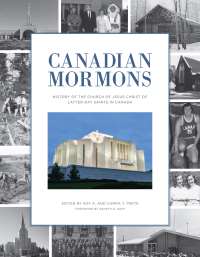
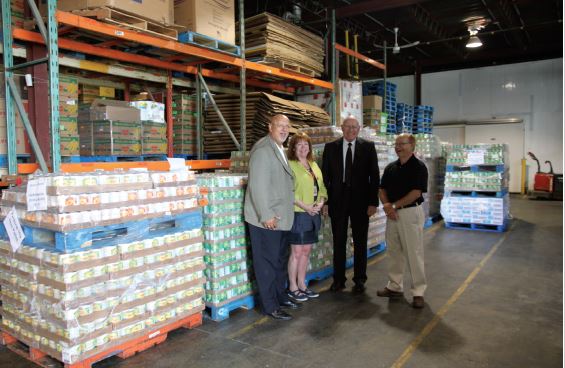 The Winnipeg Harvest food drive has been a highly successful community service project in Winnipeg, with Church-member volunteers collecting many thousands of kilograms of food each year. This photograph, taken in 2013, shows, left to right, Wayne Drozdowski, stake chair; Kate Brenner, managing director of Winnipeg Harvest; Allan N. Robison, stake president; and his first counselor, D. Randall Oler. (Yvonne Robison)
The Winnipeg Harvest food drive has been a highly successful community service project in Winnipeg, with Church-member volunteers collecting many thousands of kilograms of food each year. This photograph, taken in 2013, shows, left to right, Wayne Drozdowski, stake chair; Kate Brenner, managing director of Winnipeg Harvest; Allan N. Robison, stake president; and his first counselor, D. Randall Oler. (Yvonne Robison)